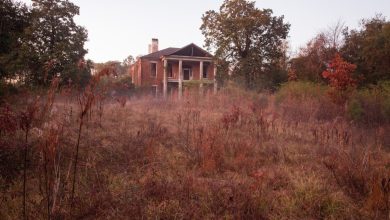Abandoned Wonder: 30 Creepiest Abandoned Places Around the World that You Must Discover Once

A post on Facebook from my teacher brought to me the idea of making this gallery of the lost world. Honestly, I was extremely impressed by the images of abandoned places across the world. There are including buildings, houses, trains, airplanes, cars, etc. around the world that are forgotten.
I don’t know how you will think about them. But right at the time I see those photos of abandoned things found on the internet, including ones from my teacher’s FB post, I immediately imagine myself being at the places to learn more about their stories. Certainly, that would be so much interesting. Hence, I make this gallery for firstly saving the places and their stories for inspiration, and secondly having a checklist so one day we will be able to come.
Now, let’s go through this gallery, and see what’s there in the lost world that is waiting for your visit!
1. The Soplata Airplane Sanctuary – Newbury, Ohio, USA

The place is called following the name of an aviation enthusiast. In fact, Walter Soplata is a scrap collector in Newbury, Ohio, USA. He had purchased and collected the warbirds of World War II with the intention of helping the aircraft from being dismantled or abandoned.
However, after his death in 2010, those airplanes were forgotten, rusted in the bushes, and turned into real waste. In total, the graveyard has about 50 rusted bodies of aircraft and 30 old engines.
The story of the Soplata Airplane Sanctuary directly from Wally Soplata, the son of Walter Soplata.
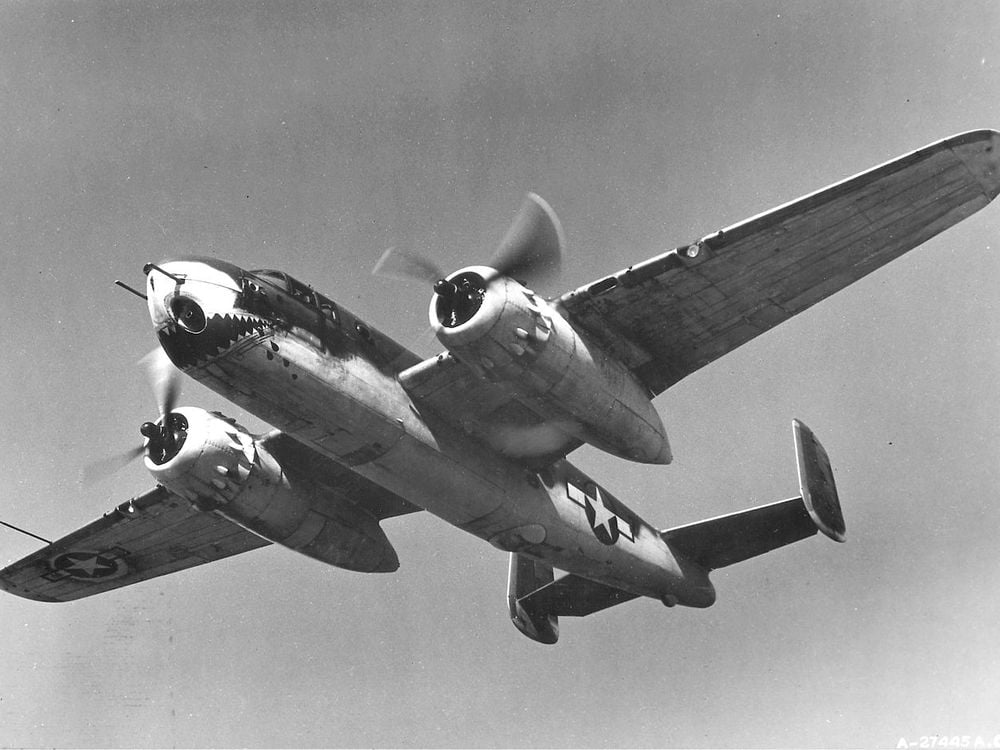
DESPITE HIS HUMBLE BEGINNINGS as the penniless son of Czech immigrants, my father, Walter Soplata, amassed an extraordinary collection of warbirds. He grew up fascinated by airplanes during the Great Depression, using whatever money he could scrape up to build balsa model aircraft. When World War II broke out, a stutter disqualified him from military service.
Dad took a job in a Cleveland, Ohio scrapyard, junking thousands of warplane engines that were suddenly declared surplus. In this job, he foresaw the near extinction of the nation’s historic aircraft. He felt he had to take action.
On land in Newbury, east of Cleveland, he began his airplane collection in 1947 with a late-1920s American Eagle biplane. A Vultee BT-15 trainer was next, and then in the early 1950s the big iron: a Vought/Goodyear FG-1D Corsair followed by another but much rarer F2G Corsair. The second Corsair, with an experimental brute-power R-4360 engine, had taken first place in the 1947 Cleveland National Air Races. My father went for the rare types: a prototype North American XP-82 Twin Mustang, then an F-82E Twin Mustang with Allison engines, an early Jet Age Chance-Vought F7U Cutlass, and a prototype of the Douglas AD Skyraider series.
In the early 1950s, my parents had four daughters and me, the only child who would pursue a career in aviation. I started in general aviation, then became an Air Force pilot and, later, an airline pilot. I cut my teeth on a twin-engine T-50 Cessna Bobcat—the type Sky King flew in the early years of the eponymous TV series—that I helped my father dismantle and haul by trailer in 1961. But of all the aircraft we dragged home, I recall most clearly a down-and-out B-25: my father’s first bomber.
One day in 1964, Dad and I were glued to our black-and-white TV set watching Thirty Seconds Over Tokyo, in which Spencer Tracy played Jimmy Doolittle leading 16 B-25 crews from the deck of the USS Hornet to bomb Japan. Dad was like a kid excited by a commercial for a toy he just had to have. He wanted a B-25.
When you consider that our home was constructed primarily of lumber from warbird engine crates discarded at a smelter where he’d worked a few years earlier, it was amazing he could think such a thing. That job had provided a meager income, and then he turned to carpentry. The housing market proved sporadic, but Dad had nonetheless managed to start an airplane collection that was already impressive. My sisters and I had the perfect clubhouse: a Fairchild C-82 Boxcar fuselage like the one in the original Flight of the Phoenix movie.
Dad rarely paid more than a few hundred bucks for an airplane. In the early 1960s, a warbird’s price was usually determined by whatever its weight would bring at the scrapyard. Regardless of our dismal financial situation, when Dad pined for a particular treasure, it was likely he would get one. Sure enough, before long a visitor touring Dad’s collection had a tip.
“There’s a B-25 down at Lunken Airport in Cincinnati that made a gear-up belly landing a few years ago,” he said. “I heard they’re going to cut it up and scrap it soon.”
Scrapped? To Dad, the thought was unbearable. He tracked down the owner who was going to scrap the B-25 and convinced the man to sell it to him for $500.
Now Dad faced the problem of getting the airplane home without destroying it. Since none of the aircraft Dad acquired was flyable, each one had to be hauled on a highway, so the size of each aircraft was a major consideration. Most of the airplanes he hauled were fighters or trainers—relatively small. Even though the B-25 was much smaller than, say, a B-17, it was still a big airplane.
Compounding Dad’s hauling concerns, he couldn’t afford a truck. All he had were the family’s 1957 Chevy Suburban and a two-wheel trailer he had fashioned from the chassis of a delivery van. Though the Suburban was an old rusty clunker, it had proven itself two years earlier when hauling the heavy wings of an F7U Cutlass jet he had won for $200 on a Navy surplus bid. But the Suburban was no match for the long, heavy fuselage of the twin-engine jet. Instead, Dad hauled the fuselage home by stuffing it in a junked schoolbus (but that’s another story).
On the down side, the Suburban, with five aboard, was cramped. Along with snacks, drinks, books, and blankets was all of Dad’s equipment: toolboxes, a stepladder, cables, chains, two bomb winches, a few jacks, and assorted wood blocks. In addition, there were spare parts for the Suburban plus several spare tires, since the bald ones Dad drove on were prone to let go. Still, except for having to rest our feet on rusty toolboxes, we were comfy.
When we reached Lunken Airport, Dad got permission to drive onto the ramp and we parked next to the B-25. Despite the story of the belly landing, the bomber, basically intact, was standing on its landing gear.
Dad’s new airplane was in civilian markings, with a Federal Aviation Agency (as it was then called) N-number on the rear fuselage. As a military-turned-civil aircraft, it was missing its gun turrets and bomb racks, though we would discover armor-plated pilot seats and a big steel ring where the top gun turret had been installed.
As expected, the belly landing had ripped much of the aluminum from the bottom of the fuselage. From watching war movies with Dad, I had expected the propeller blades to be bent and curled, but only the prop on the left engine showed this kind of damage. On the copilot side of the forward fuselage, “WILD CARGO” was crudely painted in big black letters.
“I just can’t believe it,” Dad grinned. “It’s like they made this plane to be hauled down the highway!” He showed me that all the major sections were bolted together in just the right places to allow damage-free disassembly. The forward fuselage could be unbolted in front of the wing, and the aft fuselage behind the wing. The outboard wings unbolted just beyond the engines, and even the engine nacelles unbolted slightly aft of the wing.
To Dad, the realization was like learning that the airplane would not be sacrificed to the gods. What he most hated about hauling airplanes was that some had to be cut to fit on the highway, and if a major section of the structure was cut, the airplane would be difficult to put back together and restore to flying condition.
Dad was still in mourning over his first Twin Mustang, the prototype XP-82. To haul it home, he destroyed the wing by cutting it with a torch—only later to discover bolts in a different part of the structure that would have made the torch job unnecessary. He was sick about it.
When he got his second Twin Mustang, he had learned his lesson and hauled it without any cutting. For every airplane that followed the XP-82, Dad studied the airframe carefully before deciding to cut anything.
Our quick study of the B-25 concluded, Dad went into General Patton mode and got all of us busy turning wrenches and screwdrivers. Usually I was the only one with him on trips for airplanes, but on this trip I appreciated having my sisters along; they proved to be a big help, especially Barb, who knew wrenches, sockets, and other tools by name, size, and use.
Dad would come to describe this first trip as “the easy load.” We removed all the small components— tail section, wing flaps, ailerons, landing gear doors and bomb bay doors—loaded them on the trailer, and took them home.
Dad had picked his words well: Nothing was easy after that. The first major disassembly we tackled was removing the outboard wings. From the outside, the wings looked relatively simple to remove, and Dad took just me to get them.
Along the top and bottom of the wing joint, a long row of bolts stuck into the wing, with their 9/16-inch heads protruding. Easy job, we thought. We got on top of the left outboard wing. Dad started on the first bolt, which turned without much difficulty, but that was it. It turned and turned and turned but didn’t even begin to come out. He put his socket on another bolt, and another, with the same result. “Don’t tell me they didn’t put self-holding nut plates inside the wing!” he exclaimed.
We got off the wing, and soon Dad had his wobbly stepladder under it. Good news and bad: An oil cooler was located at each wing joint, with an access panel under the cooler. But the cooler bled thick, black oil when removed, and after the cooler was out, we still could not reach half the nuts for the wing bolts.
Dad cut the rivets that held the air ducts for the oil cooler. With the ducts removed, I was able to snake my skinny shoulders through the oil cooler opening and into the wing. Struggling with claustrophobia, plus the fear I’d get stuck inside the jagged structure, I spent hours contorted in the wing as I moved my wrench from one nut to the next while Dad spun the bolts out from outside.
When it came time to pull the last bolts and remove the wing, we had another problem that would confront us on most airplane-hauling endeavors. We didn’t have a crane or lift. To solve the problem this time, Dad made a pair of H-shaped wood frames to hold the wing as the bolts were removed. A genius at making a hard job easy by constructing something cheap and simple, Dad connected the H-frames to the trailer in a way that allowed them to fold down to the trailer. Using an old bomb winch to control the rate at which the H-frames folded, we lowered the wing to the trailer. Now we were halfway done with this part of the ordeal.
We worked on the bomber every weekend that October and on into November. Many local aviation enthusiasts stopped by, and from them we learned a lot about the bomber, including the story of how the B-25 had ended up at Lunken nearly two years earlier.
As the story went, a man from Louisiana used the bomber to take a diverse collection of exotic animals from city to city—thus the name Wild Cargo. En route to Cincinnati for a show, the right engine had failed. The pilot reported to Lunken Tower that his landing gear was inoperative and declared an emergency. While the pilot circled Lunken to burn fuel, the copilot parachuted out, an event that was captured on camera by local news teams. Despite having an engine out, no landing gear, and an extreme crosswind, the pilot, by all accounts, made a perfect landing.
After the wings, we tackled the rear fuselage. Though it wasn’t that heavy, it was so long that we had more fuselage hanging off the trailer than riding on it. Making matters worse, we had the narrow end (tail gunner position) of the fuselage on the front of Dad’s two-wheel trailer. Though this arrangement allowed us to get the narrow tailcone up close to the Suburban’s rear doors to allow room for turning, it also meant the wide and heavy end of the fuselage was sticking far beyond the back of the trailer. On the highway, the load handled badly and was prone to sway left and right, limiting our speed to about 40 mph.
On another trip, we put both of the airplane’s twin-row R-2600 radial engines on the trailer together. Though the load was well balanced, the engines were very heavy. It was bad enough we didn’t have a truck, but even worse, Dad’s Suburban wasn’t too powerful. It sported a straight-six engine with a three-speed transmission that shifted on the steering column; today, people wouldn’t use a vehicle like that to pull a jet ski. Here we were dragging a World War II bomber 200 miles.
The last 20 miles of our journey consisted of some big hills in Ohio’s Chagrin Valley, and Dad was nervous, with good reason. While pulling the pair of B-25 engines up one of the hills, he had trouble down-shifting into first gear. Halfway up the hill we almost stalled out. With the Suburban built before the age of power brakes and no brakes on the trailer, I later had nightmares about those heavy bomber engines taking us for a rip-roaring backward ride down that long steep hill.
The center section of the wing with both engine nacelles, both main landing gear, and the bomb bay proved to be the heaviest and most unstable load. Still, it represented the last load. Approaching the dreaded hill, Dad shifted into first gear while we were still on flat pavement. To our relief, the Suburban’s little six was up to the task, though just barely.
Well past midnight when we got home, Dad cruised from our dirt driveway out into the field next to it. Under the light of the stars, he parked the trailer and center wing behind the cockpit section, to some extent reuniting the shadowy silhouettes. And with that, a stray-dog B-25, once hours away from the scrapman’s torch, had found a home.
We hauled airplanes through the early 1970s. We brought home a second, nearly airworthy B-25 in 1966. Also that year, we got a Republic P-47 Thunderbolt fuselage, a North American F-86 Sabre fuselage, and a complete Lockheed P-80 Shooting Star, an early pre-ejection-seat model. Oddest of those we hauled that year, a wrecked B-57 Canberra bomber was dreadfully difficult to dismantle in the bitter cold winter.
In my father, Mom saw a man driven by a strong work ethic both in his carpenter job and in his passion for airplanes. The only time she put up a fight was over the purchase of yet another FG-1D Corsair in 1960, which was likely the best deal he ever made. He paid $200 for an aircraft in excellent shape. Except for tattered fabric, it was virtually airworthy. Mom had a fit because he hadn’t told her in advance. Her first clue was seeing one of the blue outboard wings coming down the dirt road on the trailer behind our clunker Chevy.
Mom has often told me that when women at church ask her why she puts up with her husband’s collection, her standard reply is “At least I always know where my husband is.”
The year 1966 appeared to be the time when military administrators suddenly discovered they no longer had World War II aircraft for the air museums they were building. Navy and Marine Corps representatives came by, all but begging Dad for his FG-1D Corsair.
Dad was dismayed by the military’s lack of foresight, and their stricter regulations. By 1966, surplus military aircraft could not be released to civilians unless they had been demilitarized, which essentially meant cut up into small pieces. Had such a policy existed in the 1940s and 50s, it’s likely that Corsairs, Hellcats, and Thunderbolts could have ended up like the Douglas TBD Devastator. Not a single Devastator remains. Thus, despite the wrecked condition of the B-57, and the even worse condition of a Convair B-36 bomber Dad got after the Air Force destroyed, or demilitarized it, he acquired these and other shattered airplanes, to some degree, as monuments to the government’s wholesale destruction of its obsolete military aircraft. Dad continues to hang on to the wreckage of two U.S. Navy Blue Angel jets, an F-11 Tiger and F-4 Phantom II, that crashed during airshows.
His engine collection numbers 50 or so. He once had the first engine ever made by the Allison Engine Company, which he happened to get when a scrap dealer friend didn’t have the heart to scrap the rare engine—he knew Dad would give it a home. It’s now on display at the New England Air Museum at Bradley International Airport in Connecticut.
Up through 1972, Dad and I collected aircraft purchased from private individuals, aviation schools, and other non-military sources—a Douglas B-26, two Grumman TBM Avengers, a North American SNJ Texan, a Curtiss O-52 Owl.
The warbird restoration movement picked up steam about then, with others snapping up the last of the cheap and derelict World War II aircraft. Prices skyrocketed, knocking Dad out of the market. Also that year, I enlisted in the Air Force as an electronics technician and a few years later attended Air Force ROTC to become an officer and a pilot, breaking up our father-and-son airplane-hauling team.
On Sunday afternoons in the 1960s and 70s, it was common to have 30 or so visitors touring the Soplata collection. Parents and kids could climb into the cockpits of a BT-13, BT-15, T-50, T-28, SNJ Texan, FG-1D Corsair, F2G Corsair, TBM Avenger, AD Skyraider, F-82E Twin Mustang, P-80 Shooting Star, F-84F Thunderstreak, F-86L Sabre, F7U Cutlass, B-25J, Douglas B-26, and a P2V Neptune. But for the past 20 years, Dad’s collection has been closed to visitors. Now 83 and a regular on the flea market circuit, Dad has expanded the scope of his collecting to include anything and everything. To support his perpetual appetite for collecting, many of his aircraft have been sold. The first to go, in 1986, was Wild Cargo, which was restored for flight in 2005. It is the first of Dad’s refugees to fly again.
The P-80 is owned by the National Museum of Naval Aviation in Pensacola, Florida. The F-82E Twin Mustang is being restored to airworthiness in Minnesota. The F2G Corsair belongs to Cleveland’s Crawford Auto-Aviation Museum and is partially restored for static display while awaiting funds for completion. The status of a basket-case P-51 sold in the 1980s remains undetermined.
As Dad’s collecting eventually dominated every facet of family life, my sisters and I simply learned to fend for ourselves, finding after-school jobs to pay for things we needed. That said, my sisters and I all agree we are stronger adults, perhaps because of our childhood experience. To this day, we all remain on good terms, with “tolerance” being a word we all know well. There hasn’t been a family gathering at my parents’ home in over 30 years. There simply isn’t room.
2. Chernobyl Exclusion Zone – Pripyat, Ukraine
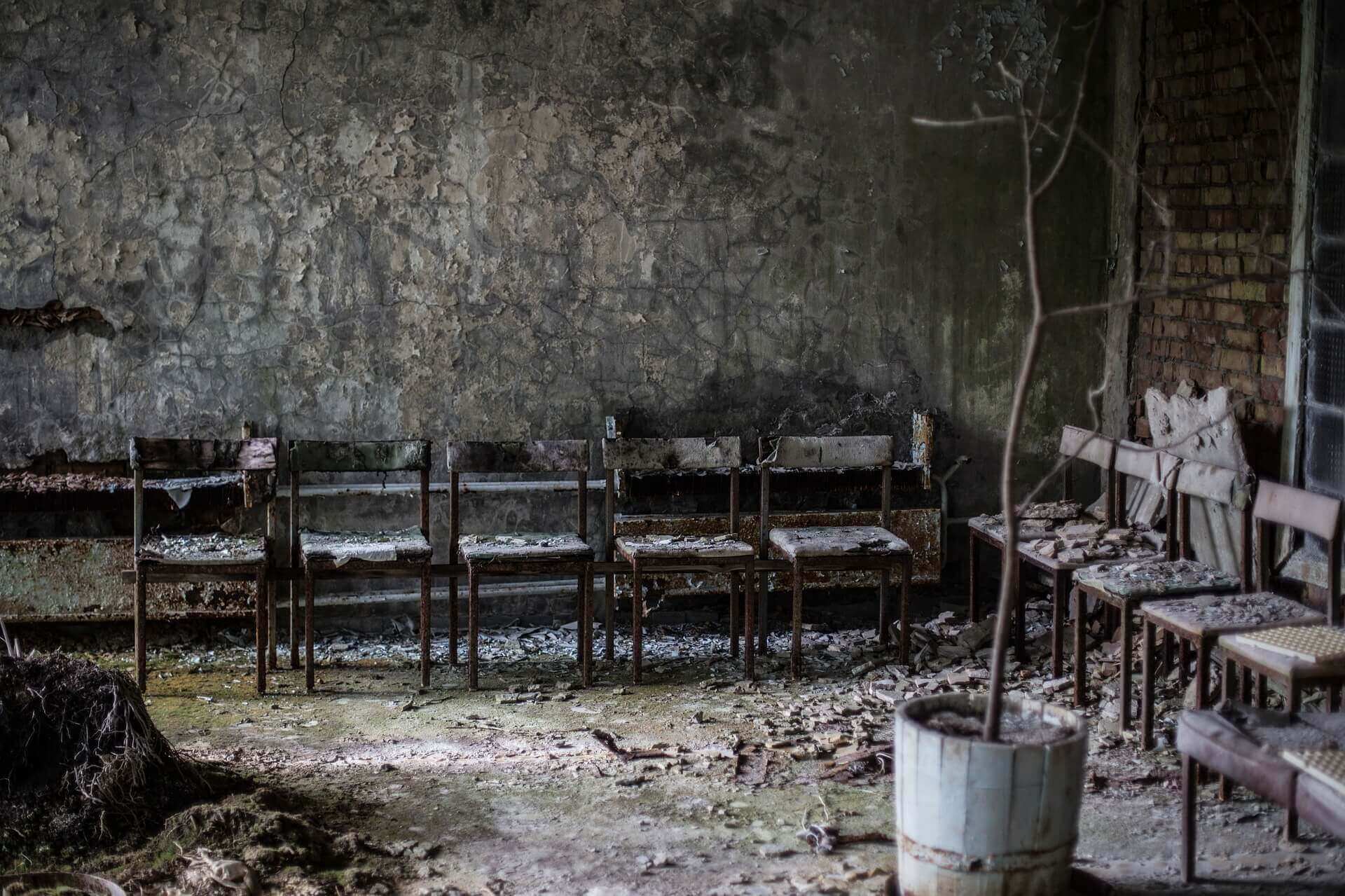
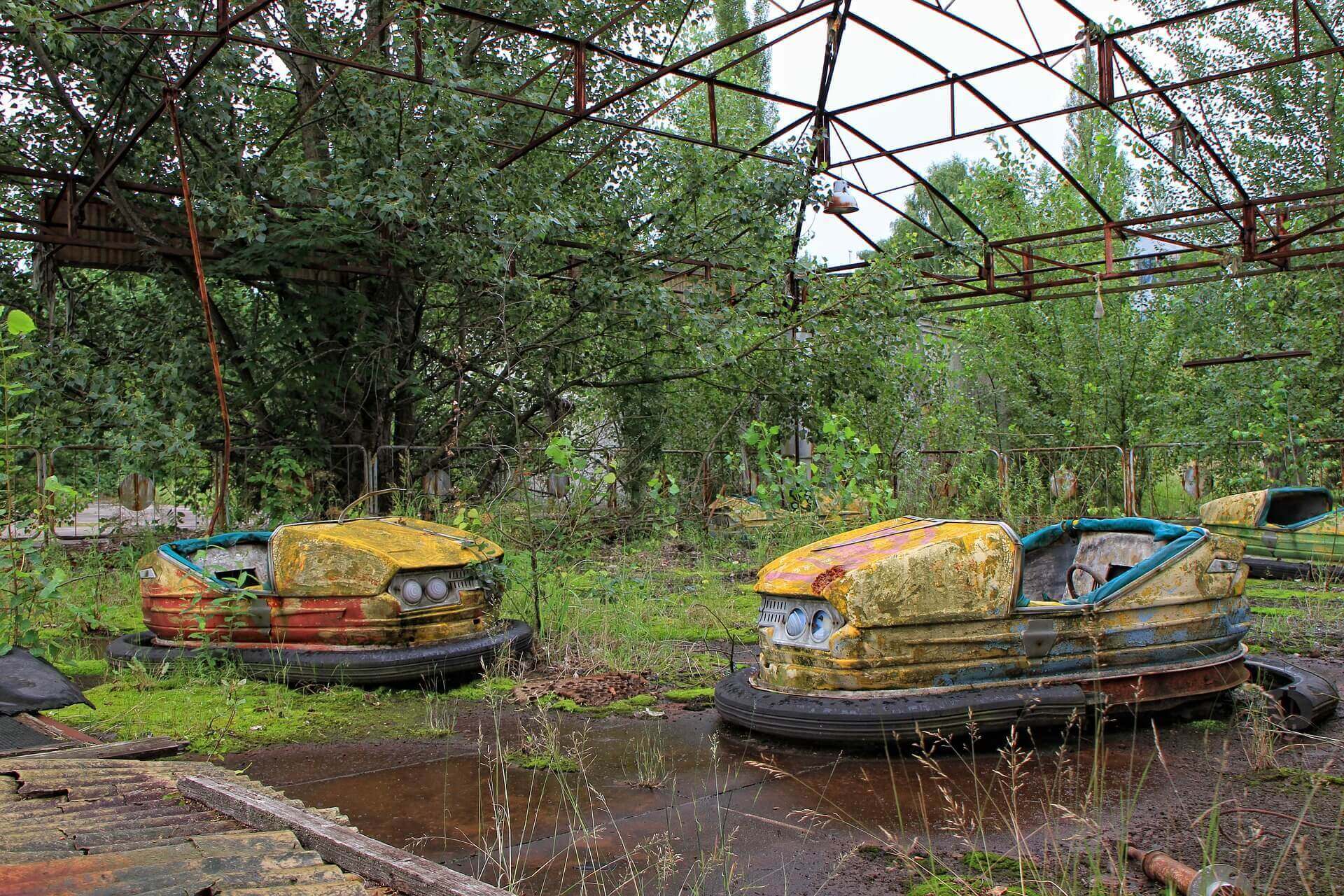
One of the most well-known abandoned places around the world, Pripyat is a ghost town in Chernobyl Raion, Kiev Oblast, Ukraine. The city was established in 1970 in connection with the Chernobyl nuclear power plant construction and was legally recovered as a result of the nuclear accident in 1986. At the time of the disaster on April 26, 1986, there were about 49,360 people living, including 15,500 children. Most of the residents are workers in the nuclear power plant and their families.
Nowadays, in order to visit the place, it’s better that you register with a licensed guide. There are many tours to Chernobyl Exclusion Zone from 1 day to 2-3 days that you can browse on GetYourGuide. Yet, don’t forget to bring enough protective clothes to protect yourself from the radioactivity left in the area.
3. Hashima Island, or Gunkanjima – Japan
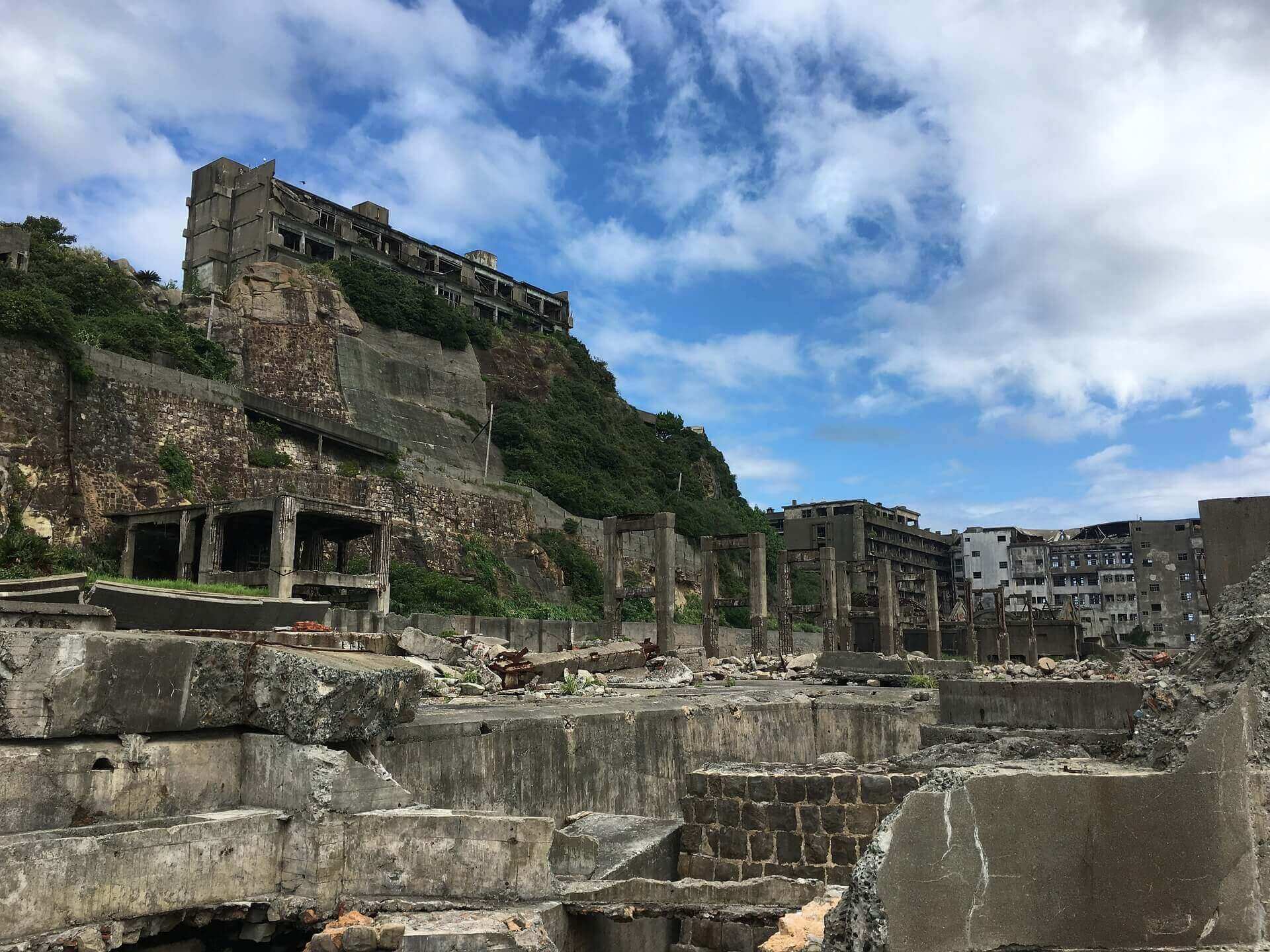
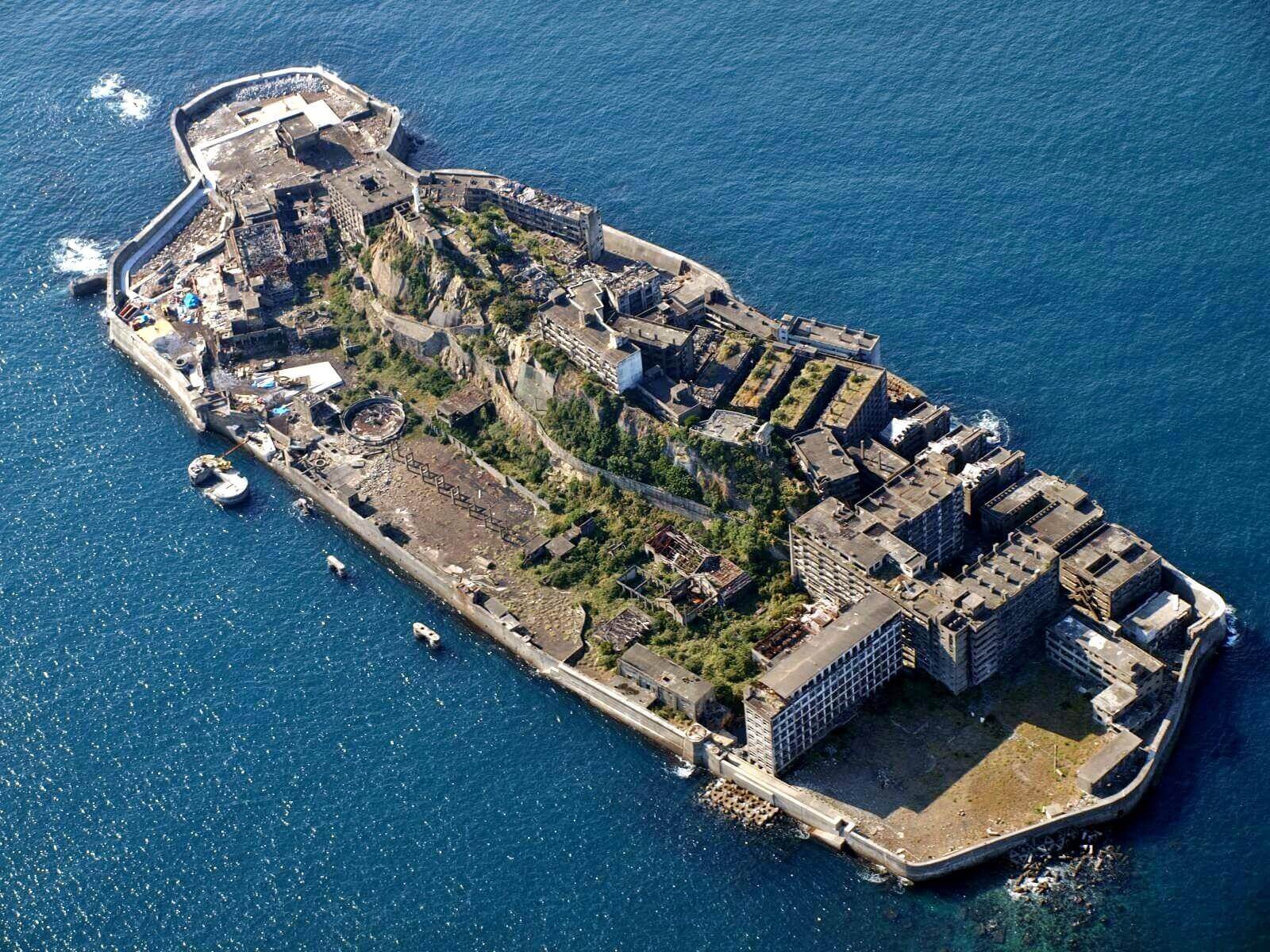
Also known as Battleship Island, Hashima currently is an abandoned island located in the south of Japan and 15 kilometers away from Nagasaki. Seen from a distance, the island is surrounded by a concrete wall with tall buildings inside that are similar to the chimney towers of a ship surfing in the East China Sea.
In fact, Gunkanjima had a long history of being a coalmine since 1890. The coal exploited here was used to support World War 2. At that moment, the island reached its peak population density at 825 per hectare, beating any records in the world. Alongside, Mitsubishi, the owner of the island at that time, built a lot of constructions from schools, playgrounds, gyms, movie theaters, bars, and restaurants to even sacred temples to serve the people there. In 1974, Mitsubishi Company announced that the mines were gradually closed. All the workers had to come back to Nagasaki. Within two months, Hashima Island became an uninhabited island.
In Jul 2015, Gunkanjima is awarded a UNESCO Heritage Site. Today, the island is open for tourists to come and explore the place. You may contact these 4 companies Gunkanjima Cruise, Gunkanjima Concierge, Yamasa Shipping, and Seaman Shokai for the cruise ship to the island. Otherwise, I suggest you check Klook for the tours to Hashima Island.
4. Maunsell Sea Forts – England
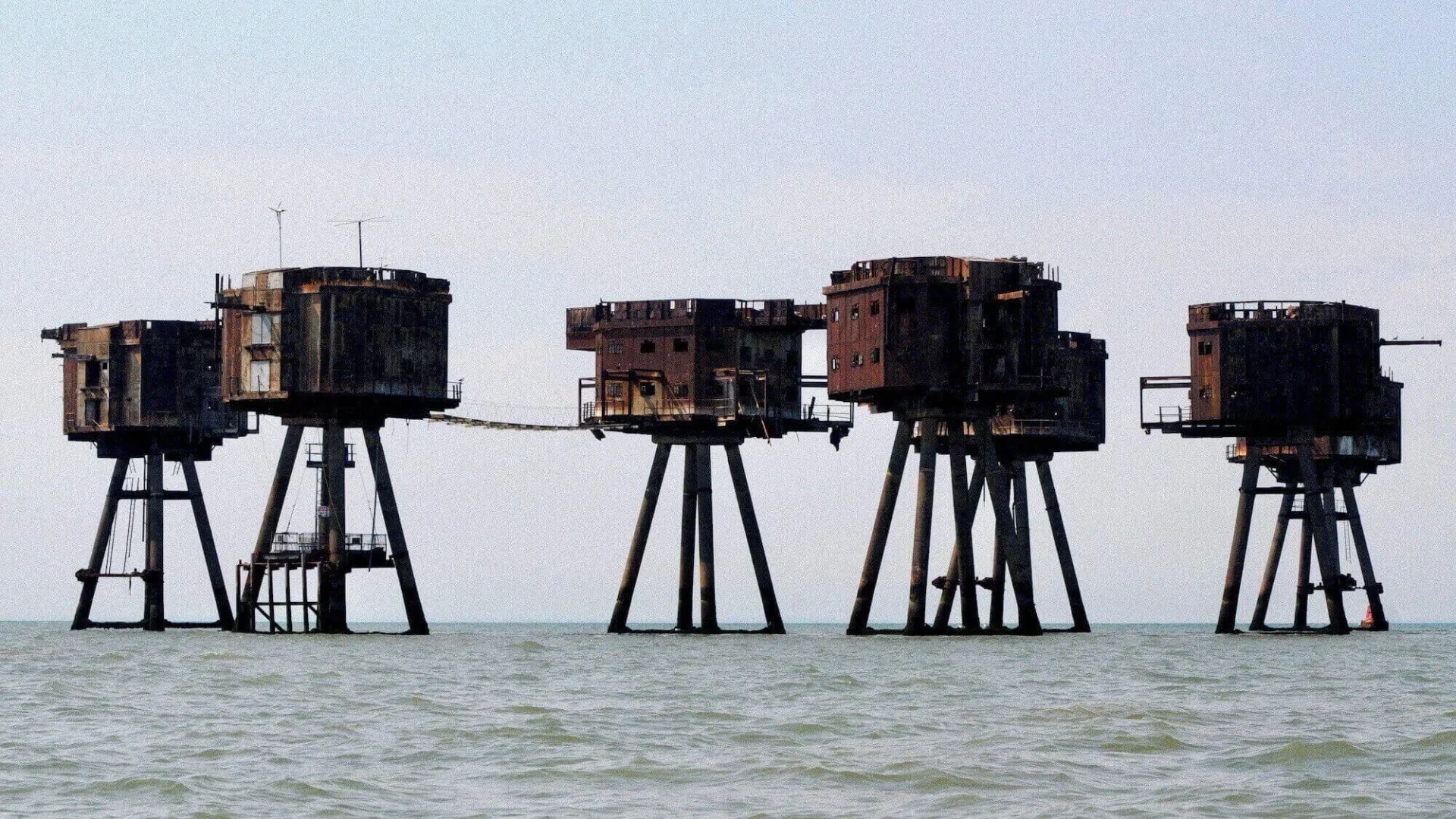
Perhaps, this is one of the most special fortifications today because they are alike the lighthouses standing on the sea. They appear in the estuaries of the Thames and Mersey rivers. The purpose of Maunsell’s construction was to protect England against Nazi submarine fleets during World War II. The towers have been decommissioned since 1950 and are now only a symbol of war. Yes, the most terrible war in human history.
I’m not sure if there is any tour offering a trip to Maunsell Sea Forts. Perhaps it’s too rusted for people to step in. Nonetheless, you can search for a boat trip to come to the forts and take photos from the outside.
5. The Ghost Ships of the Aral Sea – Aralkum Desert, the Border of Uzbekistan and Kazakhstan
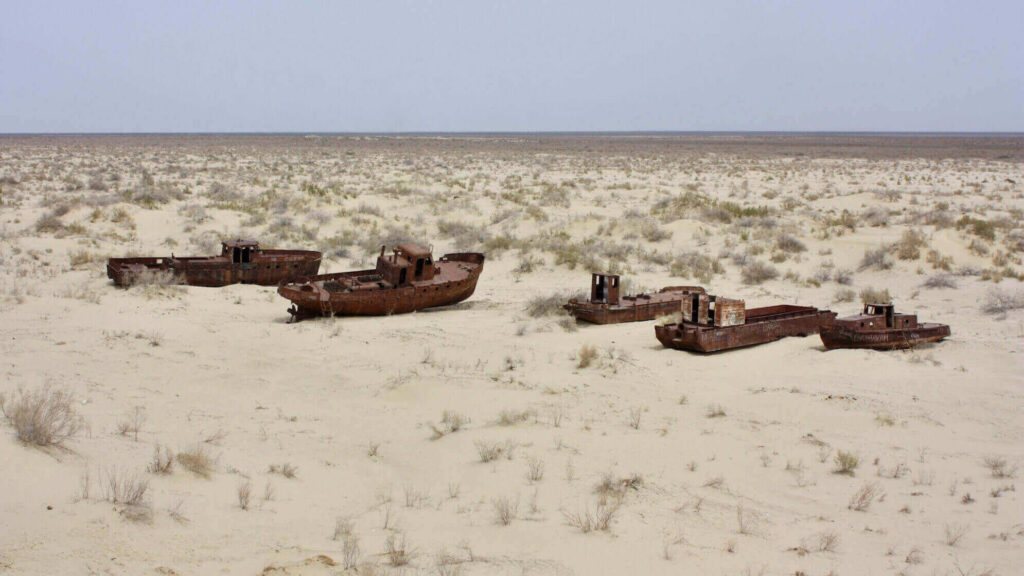
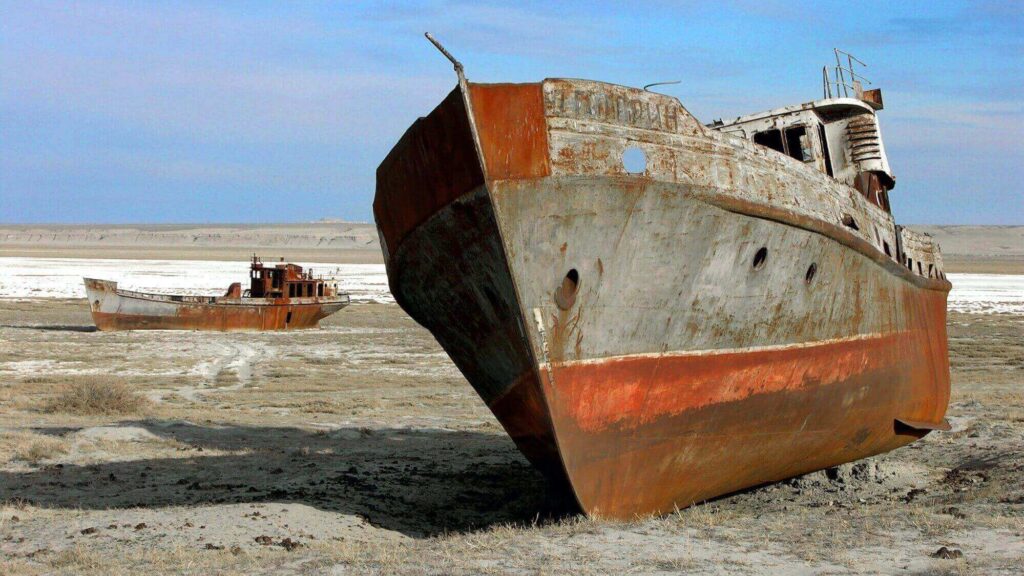
Once the world’s fourth-largest inland sea, but now much of the Aral Sea has disappeared into an arid desert. Recently, it’s known as the Aralkum Desert, with a series of rusty fishing vessels abandoned.
A long time ago, the fishing industry and the former Aral Sea canning industry, which is located on the border of Kazakhstan and Uzbekistan, flourished. The town of Moynaq was once a top attraction for a series of giant fishing boats.
However, the turning point occurred when the Soviet Union decided to divert the rivers flowing into the Aral Sea for water to irrigate the cotton fields in Uzbekistan. Seawater gradually dried up due to lack of water and evaporation in the 1960s. The water level decreased significantly, the Aral seawater became saltier. Marine organisms gradually died due to increased concentrations of fertilizers and pesticides.
Actions are being taken in order to restore the Aral Sea from being one of the abandoned places for too long. Recently, it’s tough to travel to ghost ships, but there are jeep tours that you can take to pass the desert from both Ubez and Kazakh sides.
6. Vallone Dei Mulini, or Valley of the Mills – Sorrento, Italy


The valley filled with well-known flour mills in Sorrento was built in the 13th century. Up to the 20th century, because it could not meet the needs of modern technology and faced some legal problems, it was abandoned in 1940. Nowadays, the place has returned as a top destination of the lost world for exploration by those who love the mystery and wilderness.
In contrast to the way of reaching the Aral Sea’s ghost ships, it’s not hard to go to Sorrento. The ‘Valley of the Mills’, or Vallone Dei Mulini, is only 1.5 hours away from Naples. There are plenty of airports around the world that have direct flights to Naples, Italy. Then, you can follow Google Maps to get to the point.
7. Houtouwan the Abandoned Fishing Village on Gouqi Island – Zhoushan, China




Images source: Ivan Camacho on Pinterest.
People say that the village is swallowed up by mother nature. In the past, this fishing village on Gouqi Island is inhabited by fishermen. Nevertheless, it was abandoned later due to the development of industries such as shipbuilding, light industry, and tourism. After the village is forgotten, nature has covered this place with a green moss wall. Moreover, everything in this place is still intact, making this abandoned world even more creepy with the cold air due to the trees. Are you seeing this village similar to one of the abandoned places in horror movies?
Fortunately, there are hosts that open the tour to visit Gouqi Island and the abandoned fishing village. The tour’s price is roughly CNY 2,000, which is about USD 300 for a 3-day tour.
8. Kolmanskop – Namib Desert, Namibia
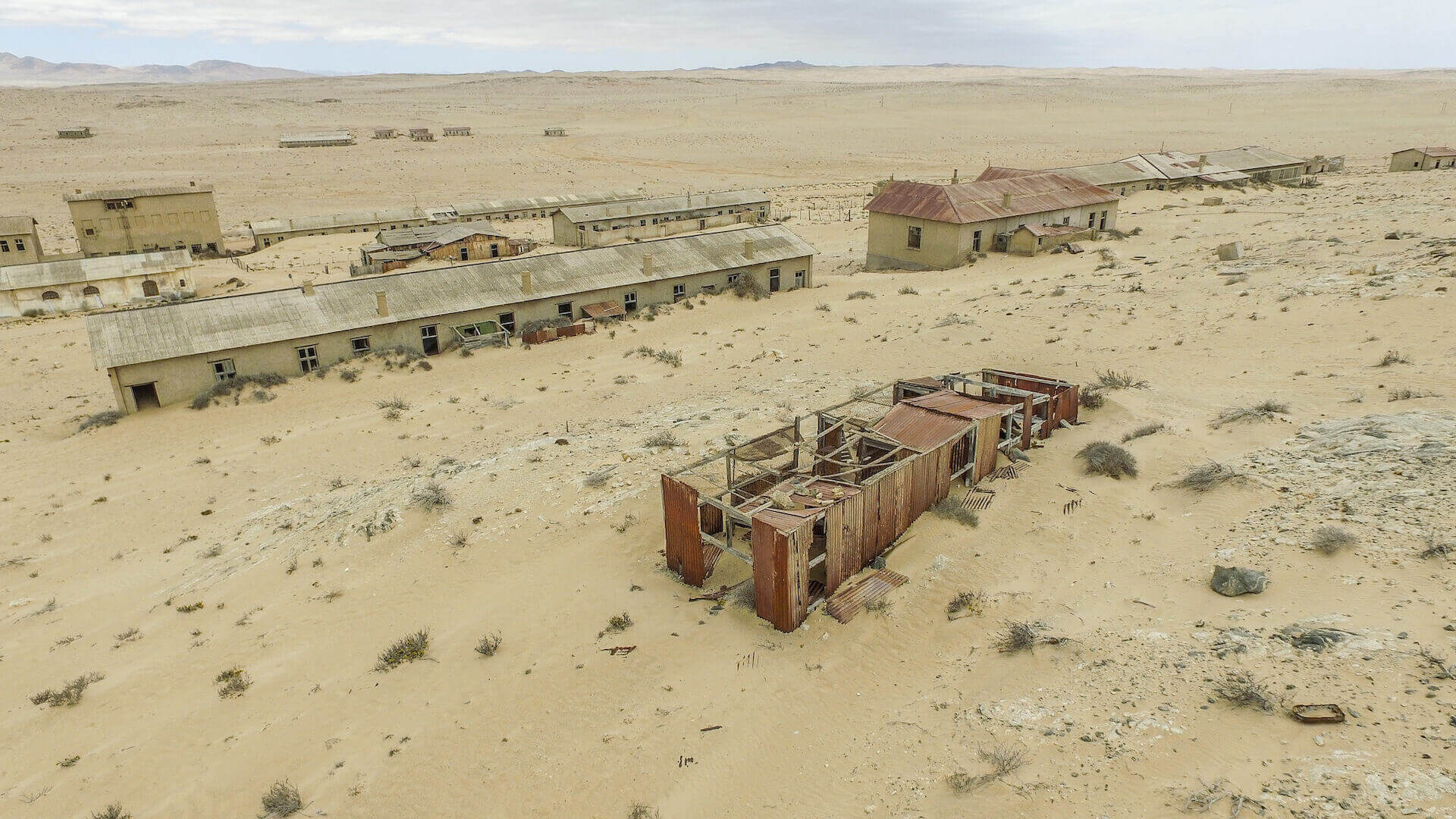
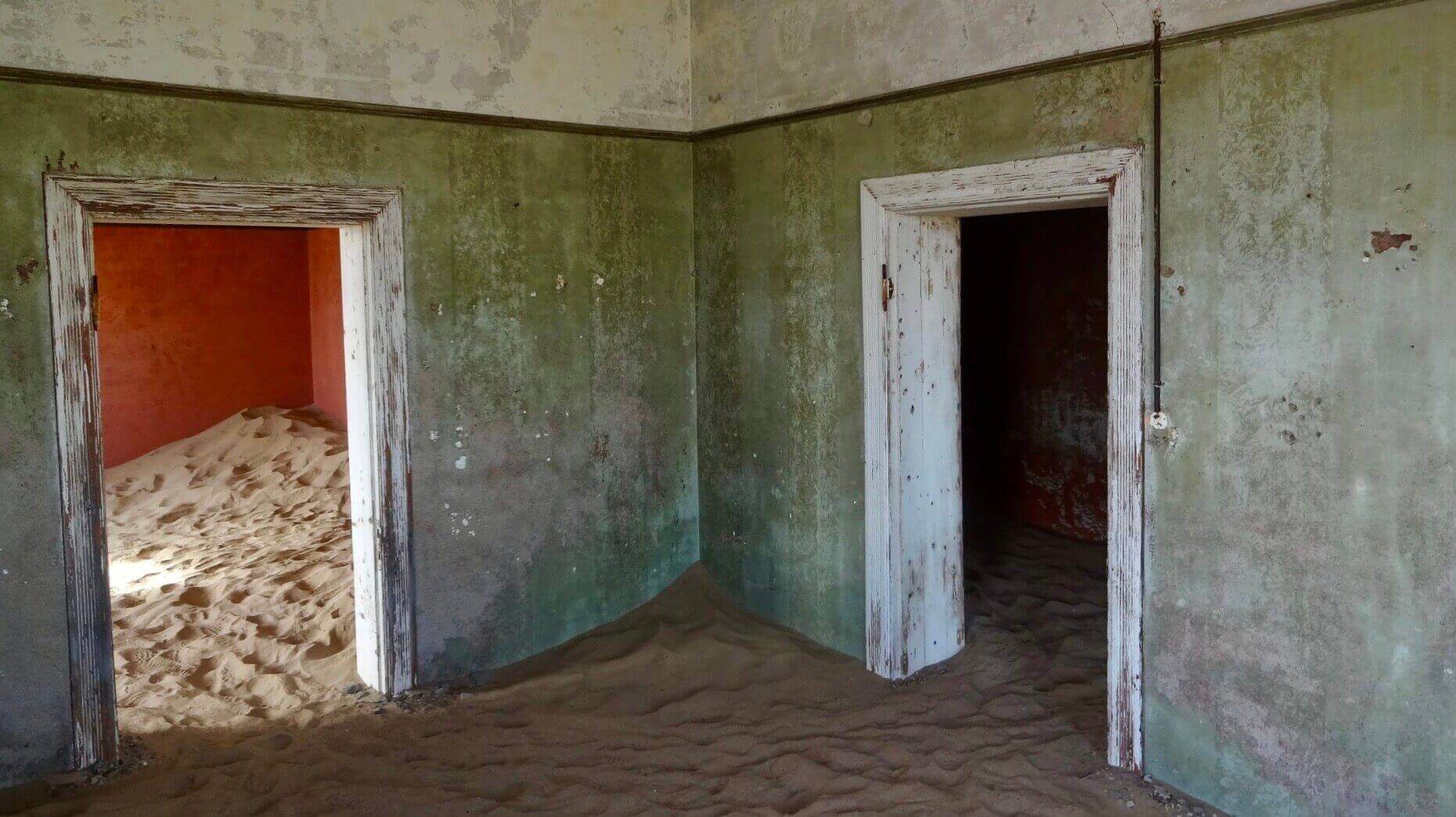
The sand is invading houses in Kolmanskop.
Being one of the most abandoned places across the world, Kolmanskop is a famous ghost town located in the Namib desert in southern Namibia, just a few miles from the port town of Lüderitz. In fact, it used to be a small town but extremely prospered thanks to its valuable diamond mines. Evenly, the hospital here used to own the first X-ray machine in the southern hemisphere. Yet today Kolmanskop is abandoned, fighting the wind, sandstorms, and desertification on the black continent, which slowly devouring the town.
At the present time, the ghost town’s ruins have little resemblance to their former glory. The wonderful houses have been almost destroyed by the wind and the sand that is knee-deep. By 1980, the mining company De Beers, a new owner of the land, began the work of restoring buildings, establishing a museum, and opening a new tour of the ghost town. Furthermore, Kolmanskop is an inspiration for many photographers to come here to shoot beautiful photos. It is also a tourist attraction with old pristine buildings with desert sand spread all over the houses.
9. Dadipark – Moorslede, Belgium
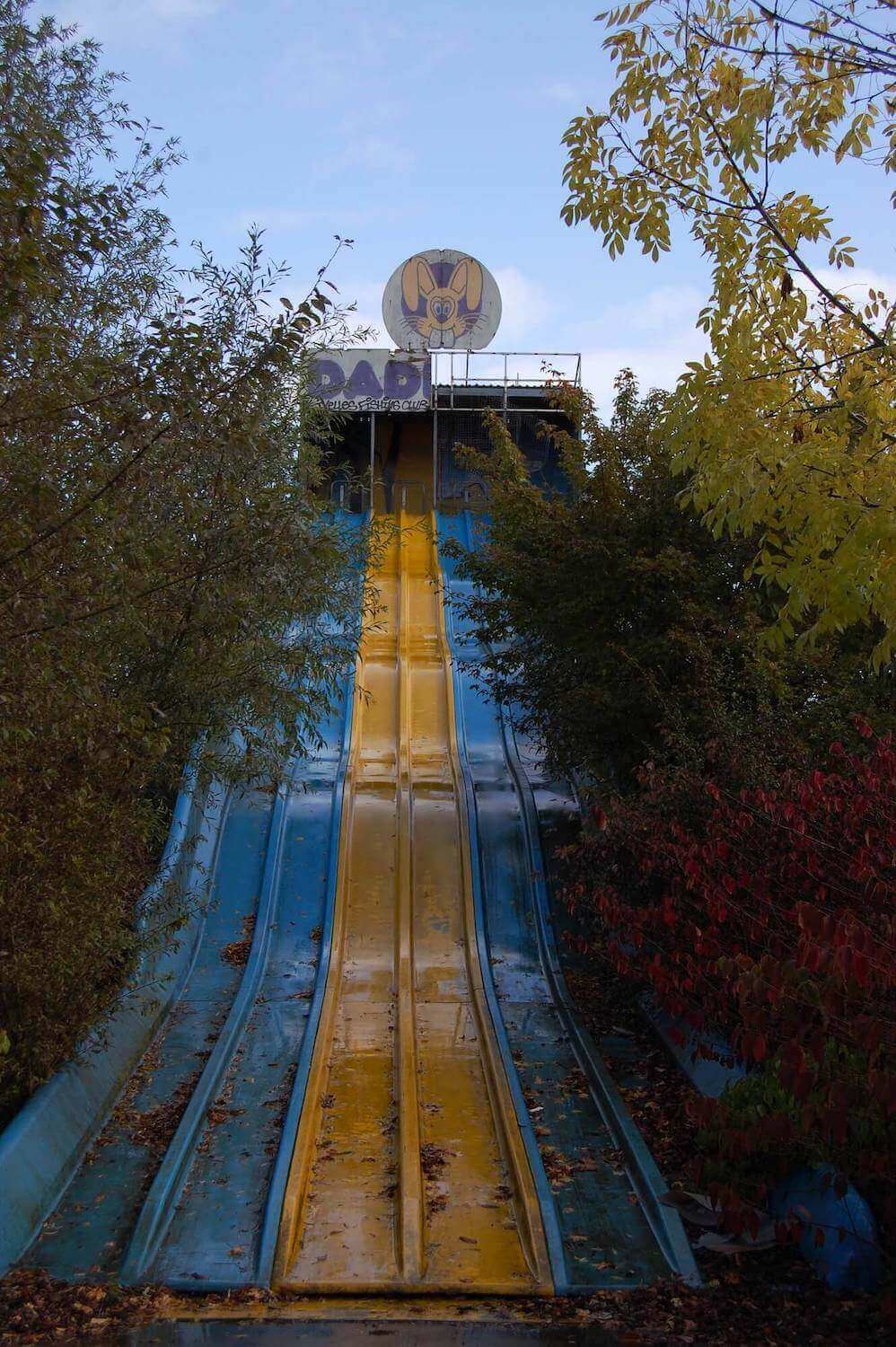
Image credit to Pel Laurens on Wikimedia.
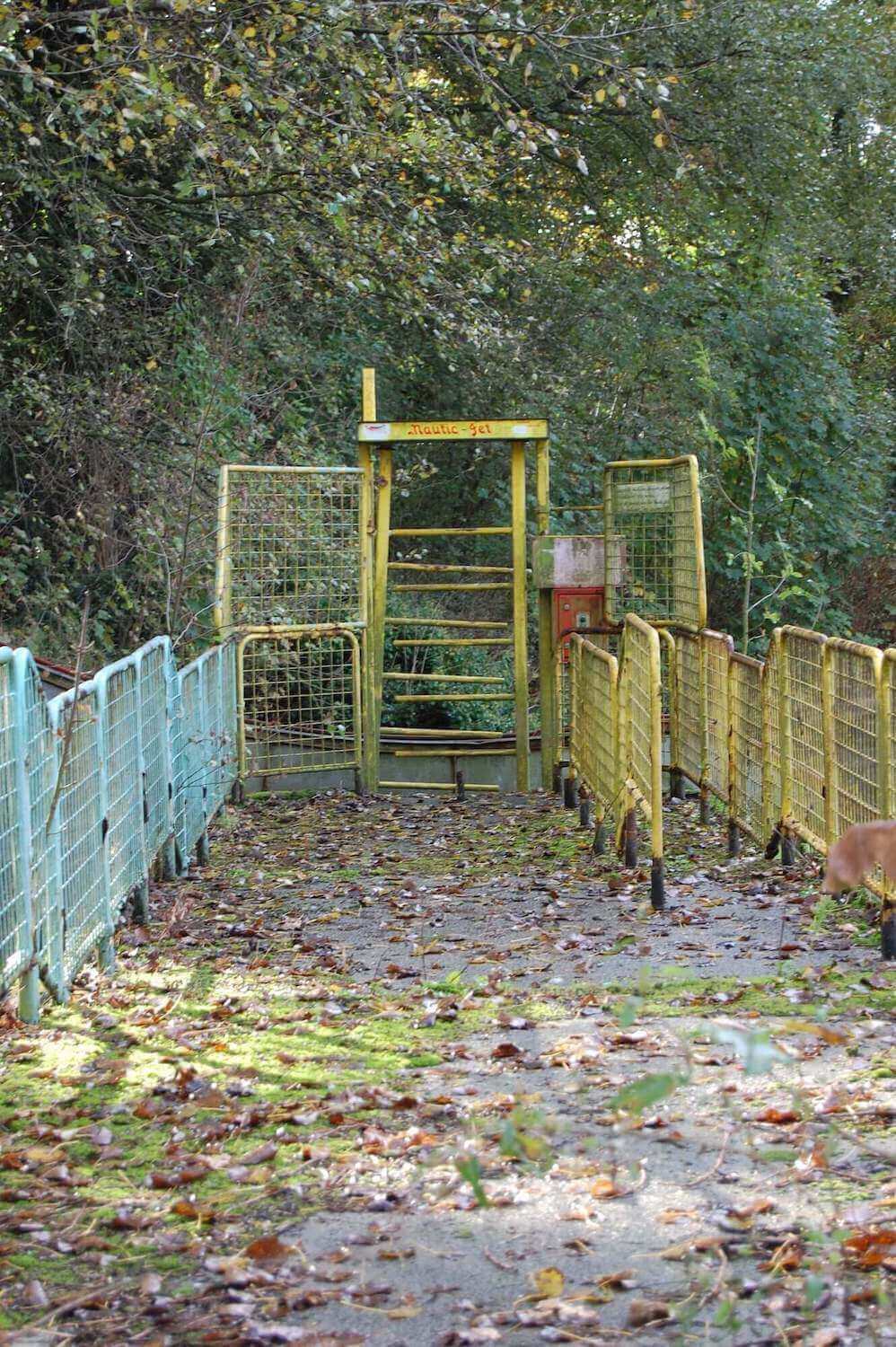
Built in 1950, Dadipark attracted more than 1 million tourists to visit each year. In the high season, visitors had to queue up to 800m long.
However, things started to get worse, as investors increased the danger level of the games but took the safety lightly. In 2000, a 9-year-old boy lost an arm while playing the Nautic Jet ride. After the accident, many people were afraid to come to the park, which led to a visitor shortage. In 2002, the park announced its temporary closure for repairs and quality improvements. Unfortunately, these improvements have never been implemented and the park has never opened the door to visitors again.
Dadipark momentarily became an abandoned amusement park without a shadow of people. At this moment, Dadipark is described as a creepy, desolate, and chaotic place covered in a cold, desolate atmosphere.
10. Abandoned Train Depot – Częstochowa, Poland

Image source from a guy on Reddit.
Perhaps this is one of the most popular abandoned pics of a railway station found on the internet. In reality, this train depot is a popular tourist destination in southern Poland. In the mid-1800s, it was once a part of the Vienna-Warsaw railway line. Presently, it’s a house to the old trains left.
11. Willard Asylum for the Chronic Insane – New York, USA

In 1869, Willard asylum was officially put into operation, becoming a home for people with disabilities, people who had no home or were being rejected by society. Nonetheless, Willard was essentially no different from a prison. Truly, patients were “detained” and treated with various barbaric methods until the doctor’s approval before being discharged from the hospital. Sadly, many people couldn’t escape this place until the end of their life. Inside Willard’s campus, a cemetery is built to bury over 5,500 patients, but their gravestones are only engraved with numbers instead of names.
Although it was closed for more than 2 decades, when referring to Willard asylum, people couldn’t help but shudder to remember a terrifying place, once detained and treated patients with inhumane methods. Definitely, Willard Asylum is listed as one of the top creepiest abandoned places around the world.
There was once an asylum opened for tourists, but not sure if it does at the moment. If you would like to visit Willard, you can try to buy a ticket to Camp Edgemere. Be quick, the tickets might be sold out fast!
12. Sanzhi UFO Houses – New Taipei, Taiwan
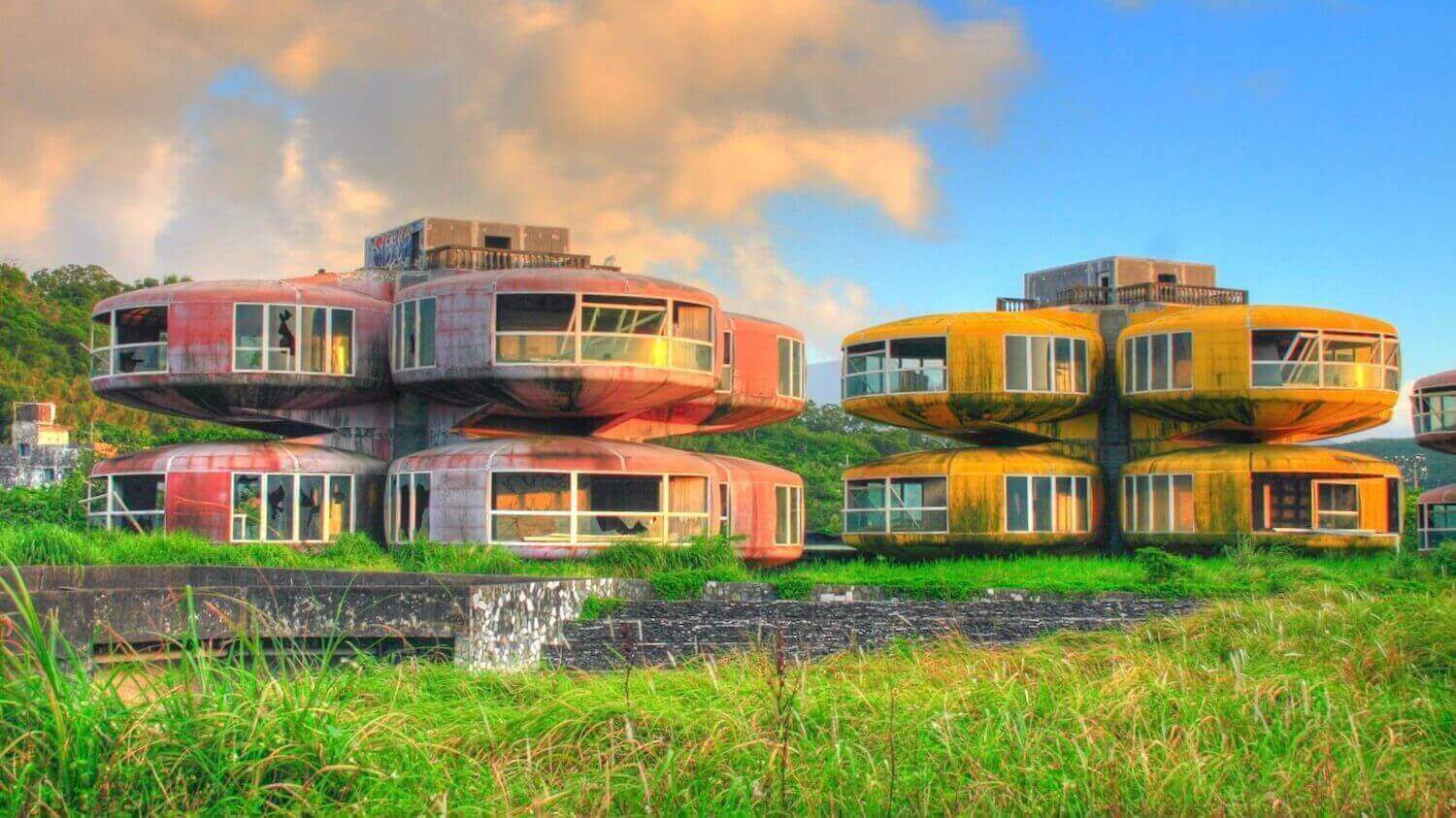
With an ideal location near Taipei and unique UFO architecture, the Tamsui resort was predicted for a bright future to become a favorite and frequented place of the middle and upper classes. Nevertheless, it unexpectedly became one of the most haunted abandoned places on the Taiwanese peninsula after only 2 years of construction since 1978. There were continuous accidents that happened to the workers at the construction and the vehicles on the road leading to the place. Believe it or not, the locals rumor that the estate used to be a cemetery of Dutch soldiers. As a result, the construction had to close.
In 1989, the president of a Taiwanese beer brand intended to rebuild the resort. Yet, the plan went nowhere. For a long time, no one cared for it, this place was so destroyed by nature that it was seriously degraded.
In 2010, the UFO buildings were demolished to give the land to commercial seaside resorts and waterparks. Now, you can only visit the place via its stories and photos.
13. Six Flags New Orleans – Louisiana, USA
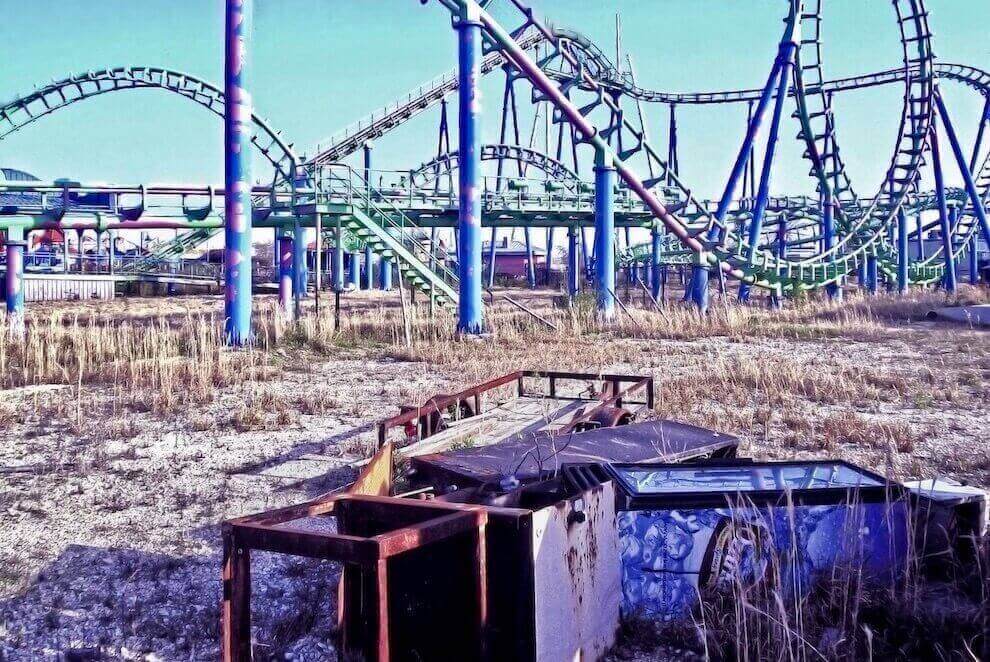
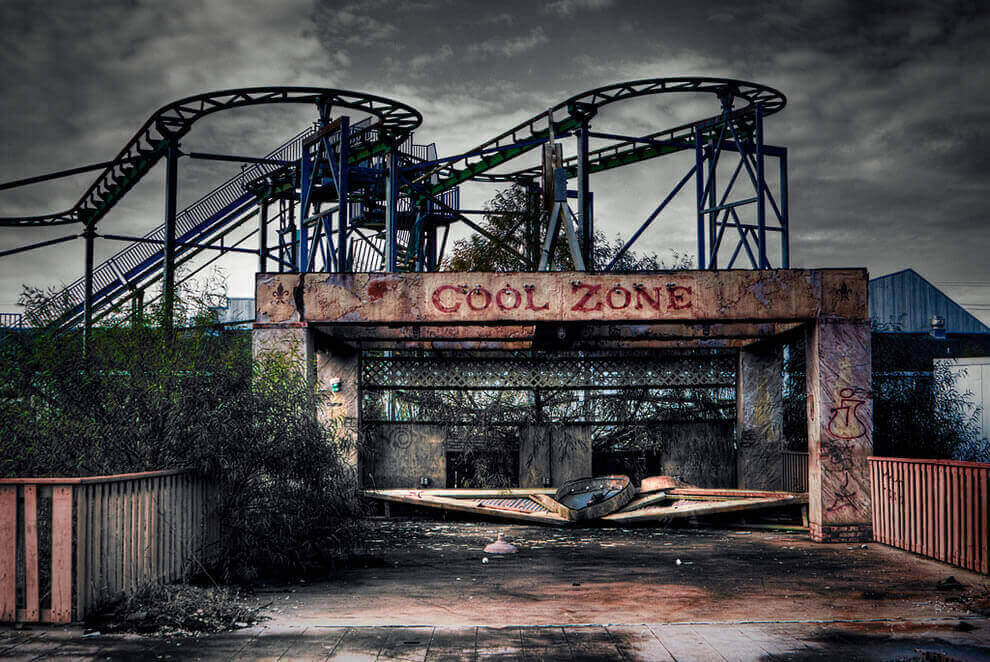
Launched initially in 2000 as Jazzland, the park went bankrupt quickly. In 2003, Six Flags claimed the ownership and reopened as the Six Flags New Orleans theme park with DC Comics and Looney Toon themes. Even so, in 2005, Hurricane Katrina hit and caused the place to sink into water tanks for a month. The damage left behind by the storm was beyond the repair and affordability of Six Flags. As a result, Six Flag New Orleans joined the list of abandoned theme parks after only 5 years of operation under two different owners.
Currently, the abandoned park has become a great spot for those who love to explore, even thieves. Yet, adventurous exploration of the park is not recommended. The reason is that after many years of inactivity, everything here has been destroyed by nature. Even, the park also has crocodiles living in the waterways.
There was news that talked about the demolition of the park in 2019. But it’s still there after years without any latest updates.
14. Gulliver’s Kingdom – Kawaguchi, Japan
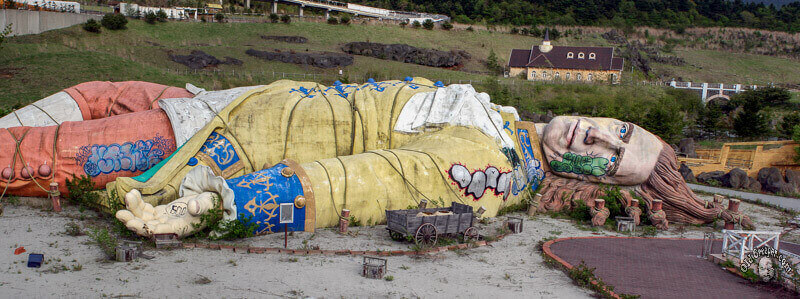
Opened to welcome visitors in 1997, this theme park was based on the novel Gulliver’s Travels by British writer Jonathan Swift. Notwithstanding, this park’s location was near Aokigahara, a well-known Japan’s ‘suicide forest’. It was also situated near the former headquarters of the Aum Shinrikyo terrorist sect, which poisoned 12 lives in a sarin gas attack in 1995. In addition, the games in Gulliver’s Kingdom were not attractive enough to get the visitors coming back. Consequently, those were the biggest reasons why Gulliver’s Kingdom in Japan quickly went bankrupt and closed after 4 years in operation.
15. Bannerman’s Castle – Pollepel Island, NY, USA
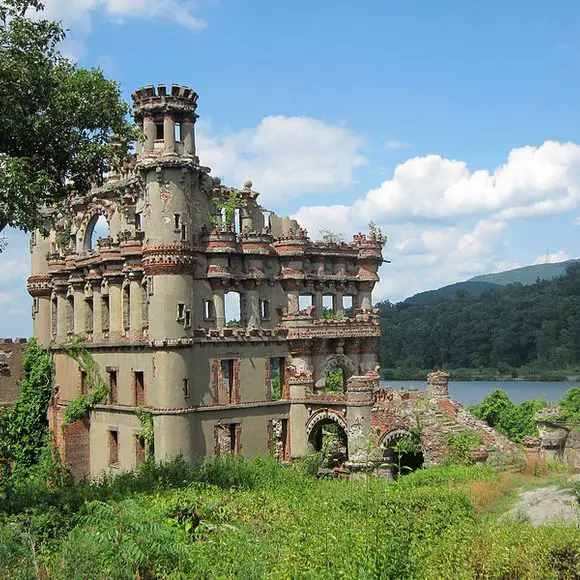
The story of this abandoned castle in Pollepel Island sticks to a man named Frank Bannerman, a wealthy munitions dealer from Scotland. He made a huge profit in the early 1900s by selling ammunition and equipment to the sides in the Spanish-American War. One day, as city laws forced him to find storage outside the city, he bought the estate on Pollepel Island and built a castle there as a warehouse to store his products. The castle was built following the style of Scottish castles at that moment.
There were unclear tales about the place as no one knew the truth. In 1969, the castle was burned, causing huge destruction. The Bannerman’s castle has joined the list of abandoned places across the world since that day. Recently, the island and castle ruins have been managed by the Bannerman Castle Trust. They even open tours and events to introduce Frank’s heritage to visitors.
16. Disney’s Discovery Island – Bay Lake, Florida, USA
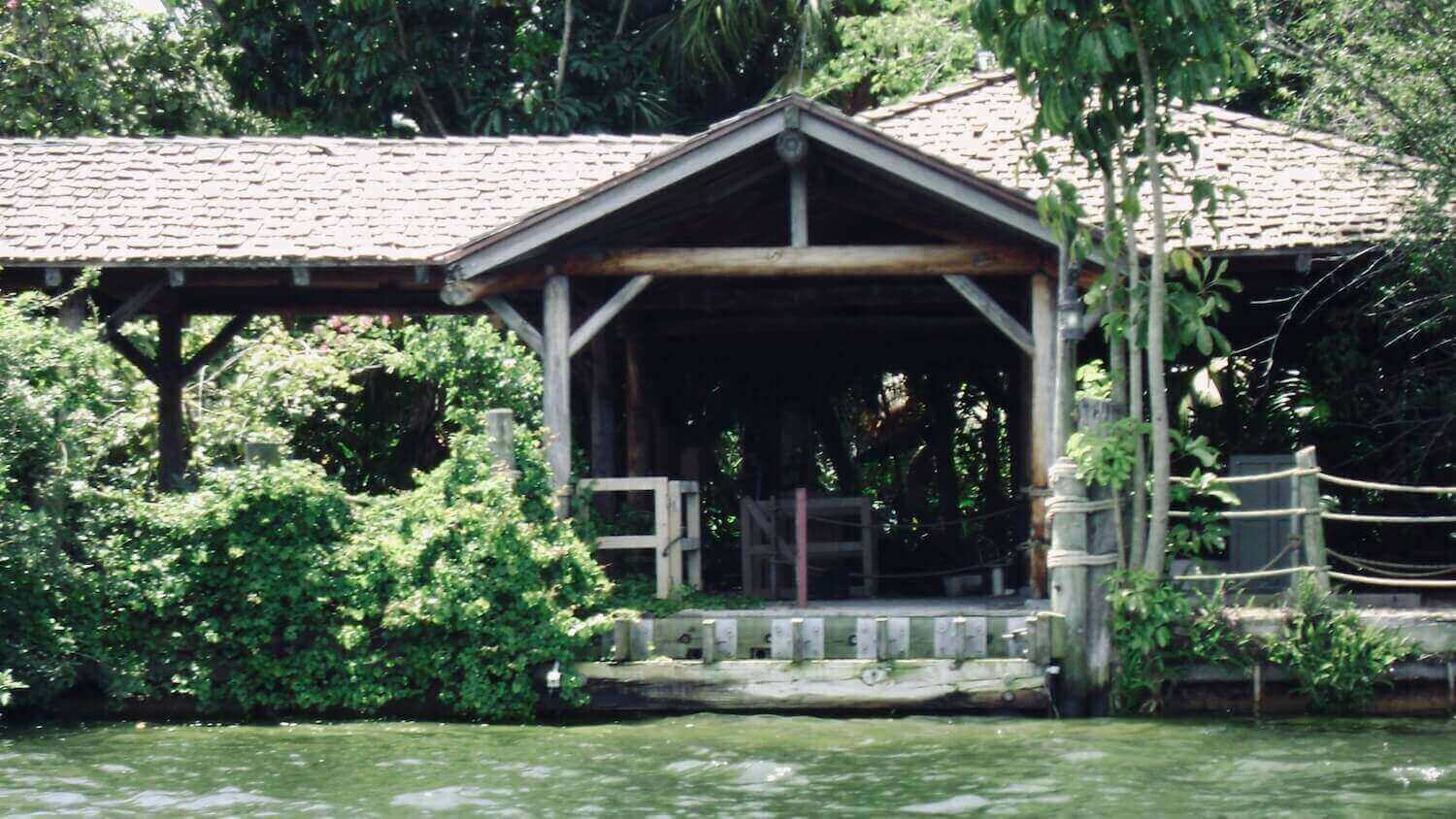
Originally, this place was called Treasure Island when it opened in 1974 as a bird sanctuary. Later, the island was renamed Discovery Island in 1978, with animal enclosures, birds, flamingo lakes, and beaches for visitors.
The site closed in 1999 for a variety of reasons such as the emergence of wild crocodiles, allegations of animal abuse, and deadly bacteria found in the park’s water. Visitors are not allowed to explore this place on their own. People who get caught on the island may be arrested and banned from entering other Disney parks.
17. Aniva Rock Lighthouse – Sakhalin Oblast, Russia
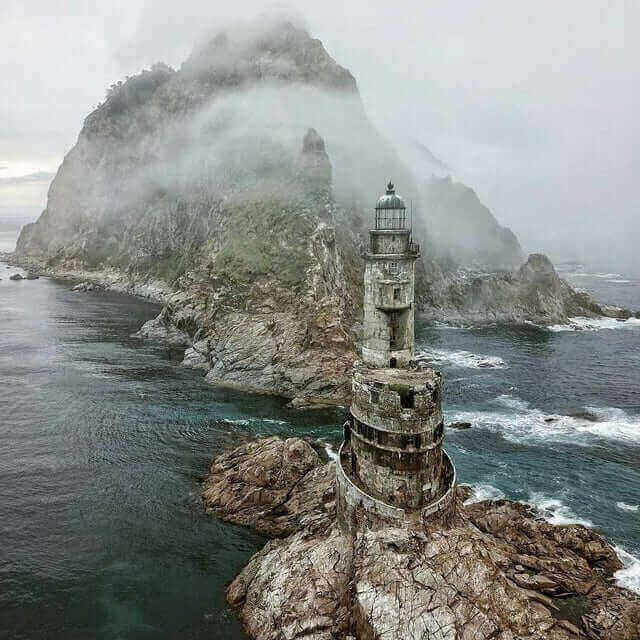
Being one of the top abandoned places, this lighthouse is beautiful with nature surrounded like a painting. In fact, this Russia’s Aniva Lighthouse is built by the Japanese in 1936 and was used till 2006. Since modern seagoing navigation took its place to replace the lighthouses, Aniva Lighthouse was abandoned.
The lighthouse is still there on the island off the southern coast of Sakhalin to impress anyone coming. If you love to visit Aniva Lighthouse for cool pics, you can approach the place by the sea. Just one thing, don’t forget your camera and flycam.
18. Château Miranda – Celles, Belgium

Image credit to Bert Kaufmann on Flickr.
In 1866, Miranda Castle in Celles, Hainaut was granted by the French aristocratic family Liedekerke-Beaufort. By World War II, the castle became an orphanage after its ownership was transferred to a Belgian railway company. Also from that time, people called Miranda Castle by the name Château de Noisy, or Noisy Castle in English. In 1980, the orphanage was moved to another place. Later, the owner of Miranda Castle faced difficulties because of its high operating costs. It was in use with no purpose for a while until it was officially abandoned in 1991.
For a long time without being taken care of, the castle became home to all kinds of mold and spider webs all over the corner. Once the most magnificent castle in the region, now Chateau Miranda is desolate, severely destroyed, quiet, and terrifying. Yes, it’s not only one of the abandoned places but probably the creepiest castle in the lost world.
Nowadays, those who come to Miranda Castle are mostly explorers, brave ghost hunters, or spiritual activists who want to challenge their fears by exploring this terrifying place.
19. Eilean Donan – Loch Duich, Scotland

There aren’t many abandoned places as rare as Eilean Donan, aka the Island of Donan. The gorgeous castle was built in the 13th century. Since then, Eilean Donan became a historical witness in the destination, including a raid of the Vikings. After many years of being a stronghold of the land, in 1719, the castle was demolished during the Jacobite rising of 1719. Later, it was left abandoned.
Fortunately, after two hundred years of being a ruin, Lt Colonel John Macrae-Gilstrap bought the island and restored the castle in 1911 – 1932. At present, Eilean Donan is one of the top attractions on the west coast of Scotland. The castle opens its doors to welcome visitors to participate in a lot of activities and events there.
20. Orpheum Theatre – New Bedford, Massachusetts, USA
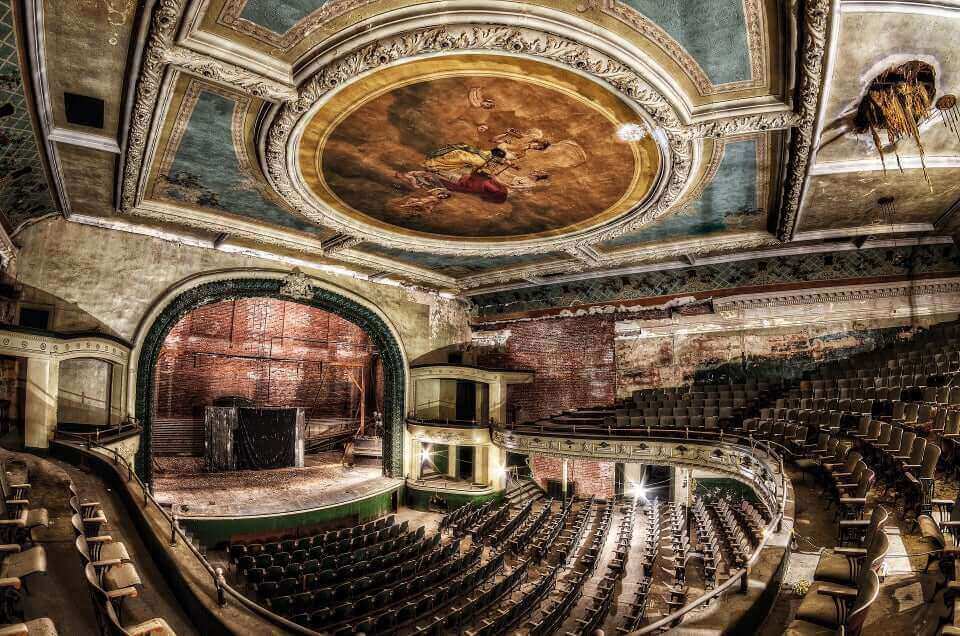
Believe it or not, this Orpheum Theatre was built exactly the same day the Titanic sank, on April 15, 1913. Also, it was the second oldest theatre in the nation, after the one in Los Angeles.
Of course, it looked beautiful, as some people say. But it was closed in 1959 after years of serving guests. Now, the whole building, which includes the Orpheum Theatre, is private property. Parts of the building are currently used for different businesses. Hence, if you want to explore the theatre, perhaps you must ask for the owner’s permission.
21. Power Plant IM – Charleroi, Belgium
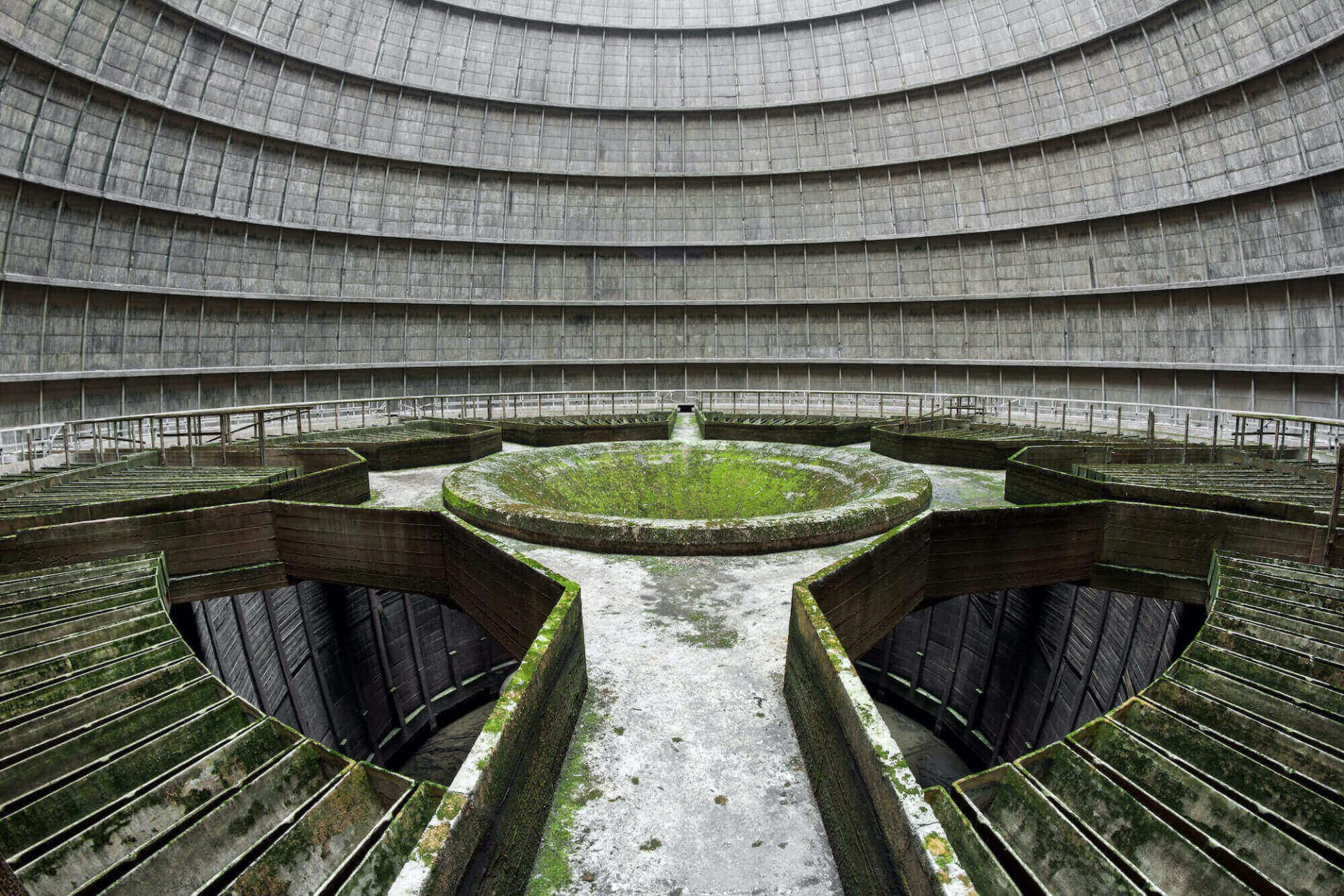
Image source: Romaine on Wikimedia.
Power Plant IM contributed its magnificent cooling tower to the list of abandoned places in the lost world. As it happens, Power Plant IM was built in 1921 and became the main electricity supplier to the country for a short time. Assuredly, as one of the biggest coal-burning power plants in Belgium, its high CO2 emissions led to the shutdown in 2007. The whole place was abandoned afterward.
In the latest update, the property’s manager has sealed off the door and removed the staircase. Possibly, Power Plant IM is going to be demolished soon.
22. SS American Star Shipwreck – Fuerteventura, the USA
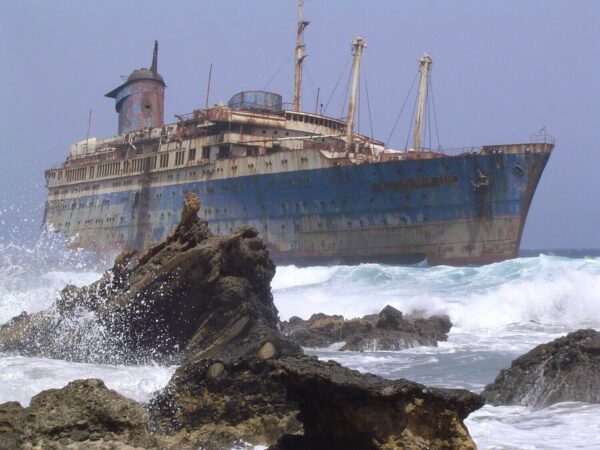
Launched in 1939 by Eleanor Roosevelt just before World War II began, the SS American Star started life as a passenger ship. Yet, it was quickly called to assist the navy in transporting American troops. After the war, the ship returned to be a commercial ship again.
In the 1990s, a group of people in Thailand wanted to turn it into a floating hotel after saving it from the rubble. Nevertheless, on the way to her new home in 1994, because of a storm, SS American Star ran aground off the coast of Fuerteventura, in the Canary Islands. As time passed, a part of the abandoned ship had disintegrated. Now, we can only see this “star” at low tide.
23. Ancient Underwater City – Zhejiang, China

Source of image: Sara Barnes in My Modern Met.
The ancient city at the bottom of Qiandao Lake named Shi Cheng, or Lion City, was built in the 2nd century, in the Eastern Han Dynasty. Up to now, Shi Cheng has existed for more than 1300 years at the foot of Wu Shi Mountain, experiencing many ups and downs of Chinese history. One day in the past, Shi Cheng was submerged by an artificial lake when the government decided to build a hydroelectric plant. Additionally, due to the heavy impact of a natural disaster, the city disappeared without a trace.
At the moment, the ancient underwater city gradually becomes a popular destination that attracts tourists to diving to explore the sediments at the lake’s bottom. Indeed, Shi Cheng attracts many professional divers, adventurous people, archaeologists, and filmmakers to record the ancient ruins. The best time to experience and admire the ancient city is in April – November yearly when the water is warmer.
24. Michigan Central Station – Detroit, USA
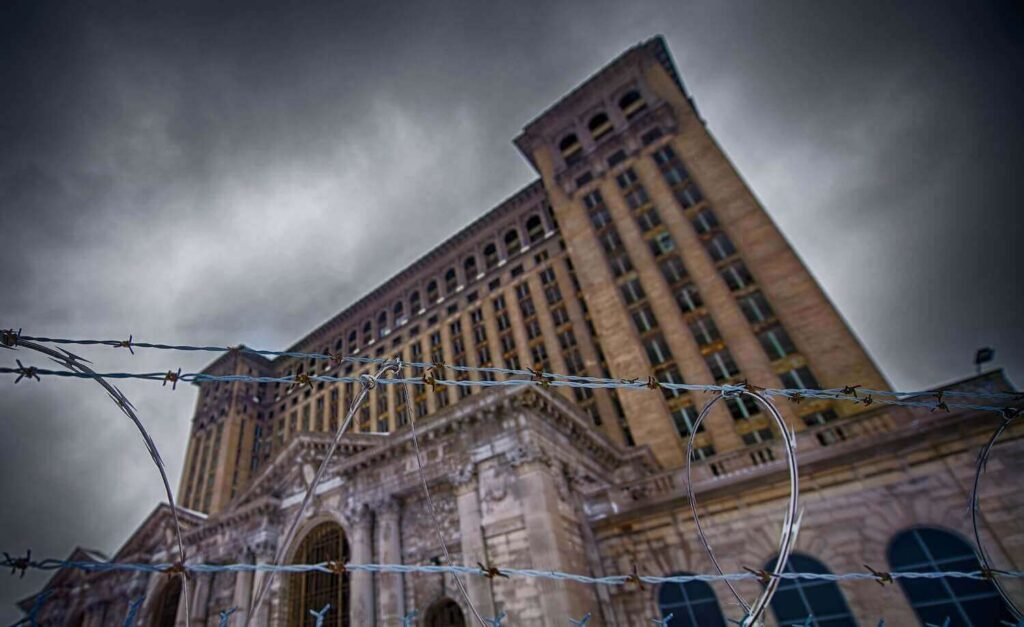

Construction of the Michigan Central Station as a major transit station began in 1913. Literally, its main purpose is serving the old Michigan and Amtrak railway systems. After World War 2, many services from the station were cut down as the number of passengers dropped. In 1967, all Michigan Central Station facilities were closed, leading its infrastructure into serious disrepair.
In 1975, the station became a National Register of Historic Places. It now only appears in action and horror movies such as Transformers, The Island, and Four Brothers, etc.
25. Beelitz Heilstätten Sanatorium – Beelitz, Germany


Beelitz-Heilstätten was built between 1898 and 1930, including 60 different buildings located southwest of Berlin, Germany. This place was built as a sanatorium for people suffering from lung diseases, especially TB patients.
For a long time after that, it was used as a military hospital. Most surprisingly, during World War I, the hospital once treated a young soldier wounded from the Battle of the Somme around 1915-16. That young soldier later was the Nazi party’s leader, Adolf Hitler. Then, during WWII, the hospital was also bombed by the Allies. And in 1945, Beelitz-Heilstätten operated as a Soviet military hospital until 1995, after the fall of the Berlin Wall.
Today, a part of Beelitz-Heilstätten has been rebuilt for Parkinson’s disease research and neurological rehabilitation. However, most of the areas such as operating rooms, psychiatric rooms, etc. are still abandoned. With its mystery and horror, this abandoned hospital in Berlin becomes an attractive destination for many curious people and explorers.
26. Hotel Del Salto – Colombia

Since 1928, Hotel del Salto opened its doors to welcome guests for about 60 years. However, as time goes on, the building became more old and rotten due to not renovated. Besides that, the neighboring Bogota river began to be heavily polluted, making no one wanted to visit this place. Since the early 1990s, Hotel Del Salto has been abandoned. Even, during the next two decades, no people came nearby the abandoned hotel as it was colder, creepy, and contained many dark rumors, except for the boring ones. Indeed, this hotel is one of the favorite places for those who want to put an end to their lives.
In 2011, the Ecological Farm Foundation of Porvenir and the Institute of Natural Sciences of the National University of Colombia joined forces to convert Hotel Del Salto into a museum. The hotel was later renamed Tequendama Falls Museum of Biodiversity and Culture, which opened for the first time in 2013. Finally, there is one of the abandoned places has given a new life.
27. SS City of Adelaide – Magnetic Island, Australia
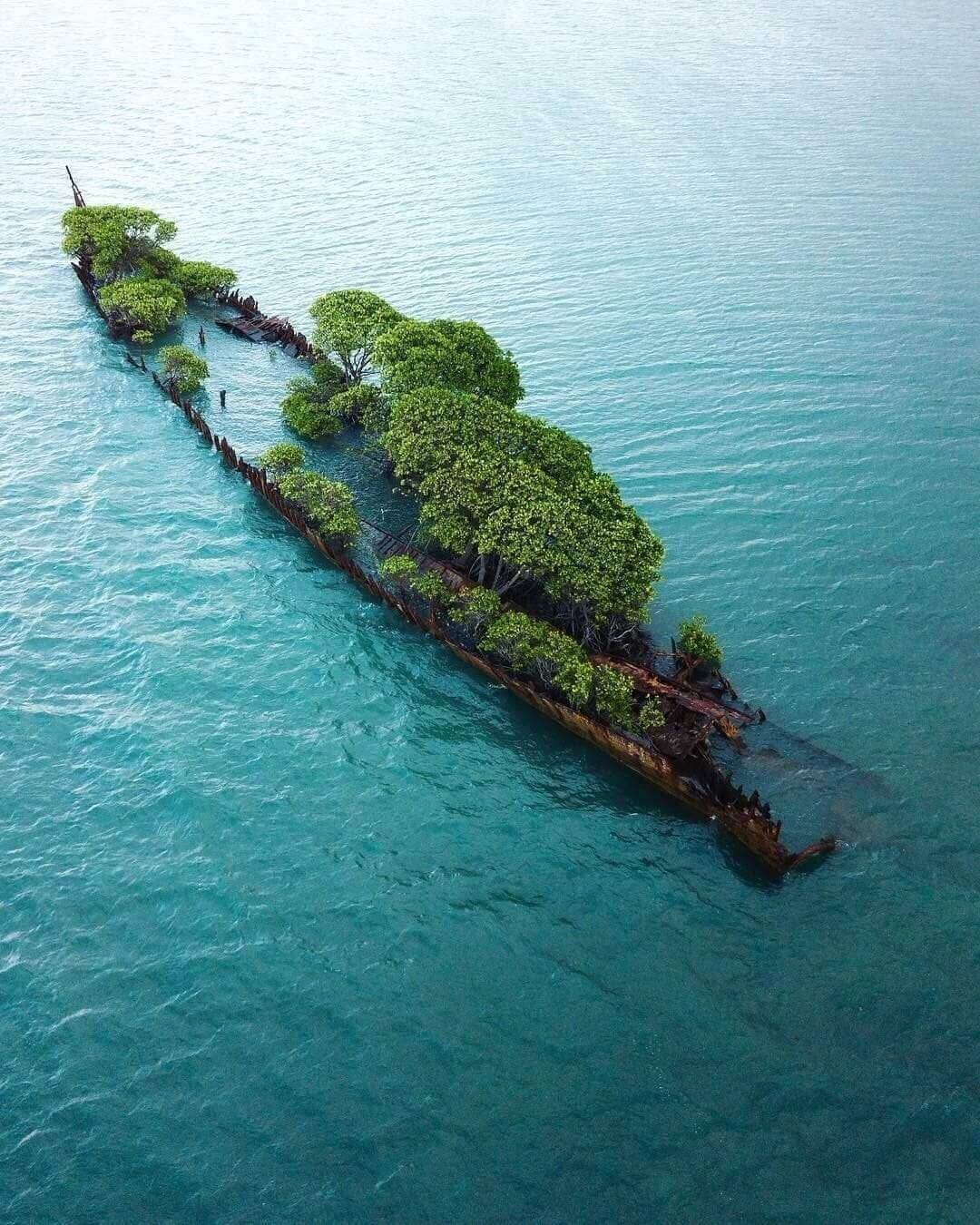
Launched in 1863, The SS City of Adelaide started its life as a passenger steamship from Glasgow, Scotland. After 30 years of working, the ship was converted into a sailing vessel to carry cargo and coal, which probably caused a fire that burned down the ship. In 1916, the leftover parts of the ship ran aground in Cockle Bay, Magnetic Island.
Today, the remains of the ship are now inhabited by mangroves, creating a ghostly scene at the Shipwreck Trail of Magnetic Island. Actually, this island off the coast of Townsville is also covered with 20 other shipwrecks.
28. Baikonur, the Soviet Space Shuttles – Kazakh Steppe
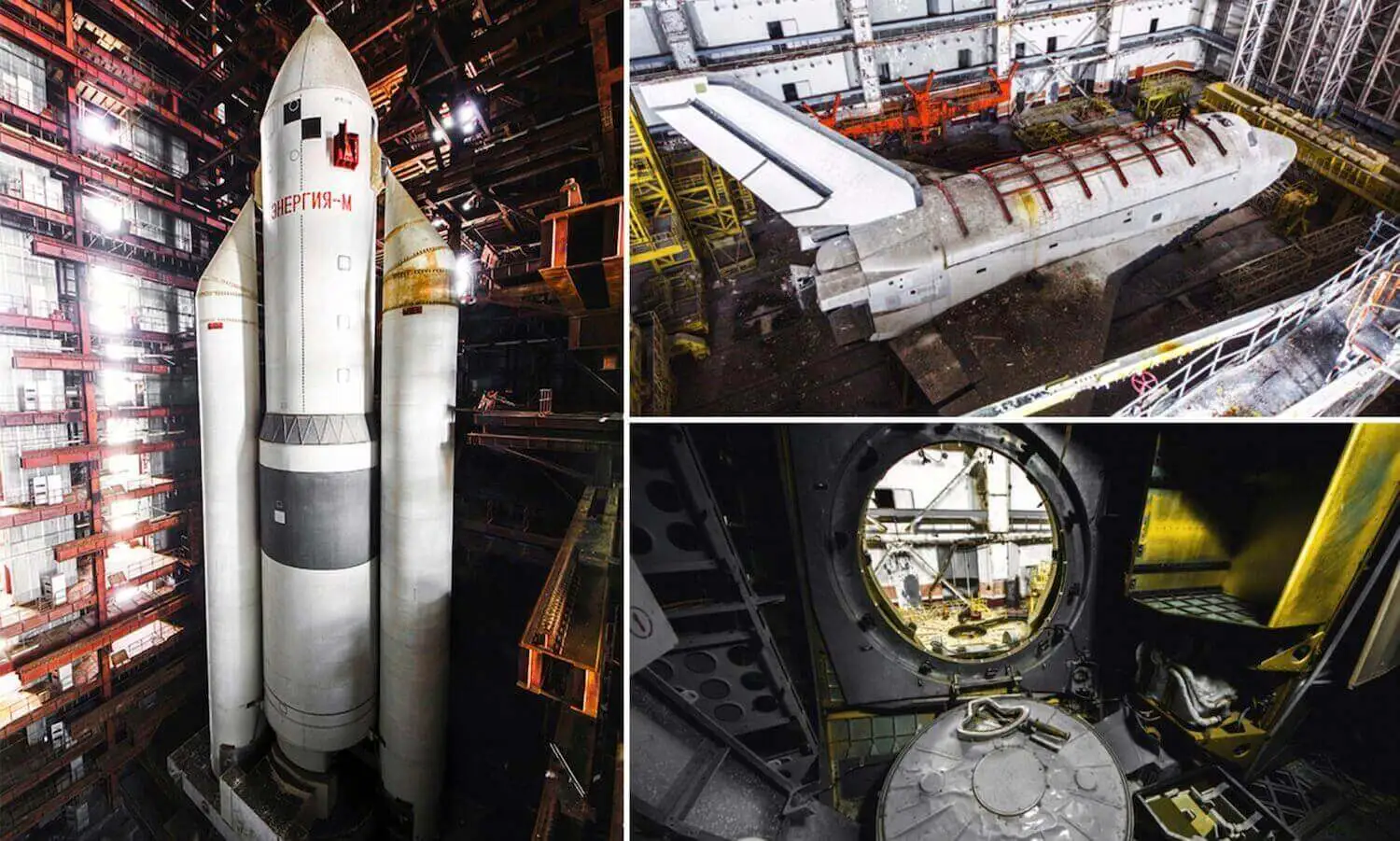
As a pioneer in the space industry, Soviet Union ran many programs to achieve its outer-space activities. Notwithstanding, with the fall of the Soviet Union, their aerospace industry’s facilities were scattered everywhere as abandoned places. Undoubtedly, those including the Buran program in Baikonur, the space shuttles which is situated currently on the Kazakh steppe.
High cost, low budget are also the reasons that add up to the abandonment of the space shuttles. Nonetheless, you are still able to visit the place in the Baikonur Cosmodrome tours that prolong up to 5 days. How great does it sound to you?
29. Wittenoom – Western Australia
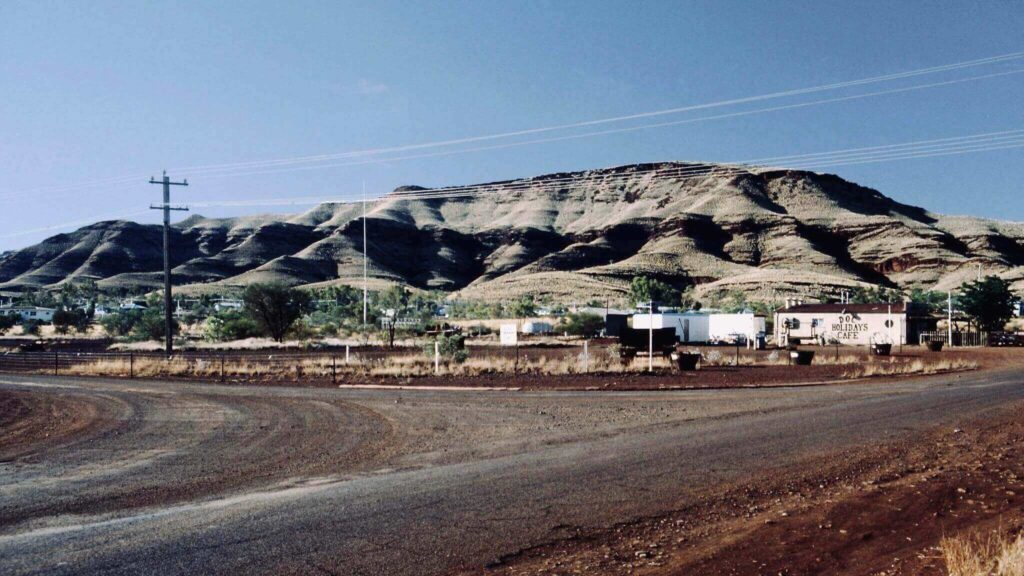
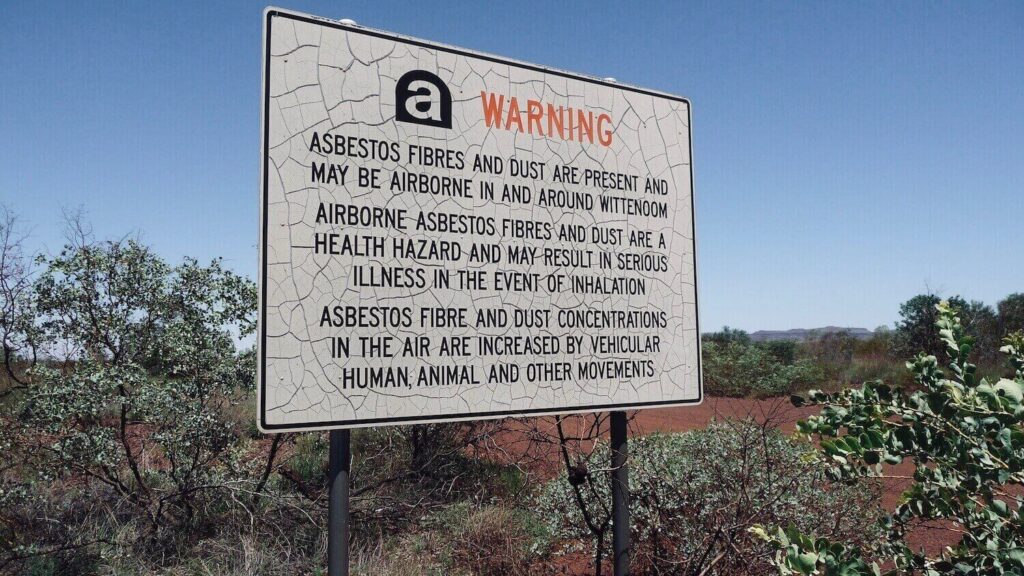
Wittenoom town in Western Australia used to have a crowded population of about 20,000 people. Thanks to the asbestos mine, the mining industry brought prosperity to the town. However, in the 1960s, this town was gradually abandoned when people realized the dangers of asbestos to human health. According to statistics, about 2000 people died (10% of the population) from diseases related to asbestos.
Wittenoom was officially removed from the map by the government and disconnected. Today, the atmosphere in the mine is abandoned, but the entire town and surrounding area are still contaminated with deadly asbestos dust. Even so, despite the health risks, some reckless travelers still come to check-in.
30. The Ancient Roman City of Pompeii – Italy
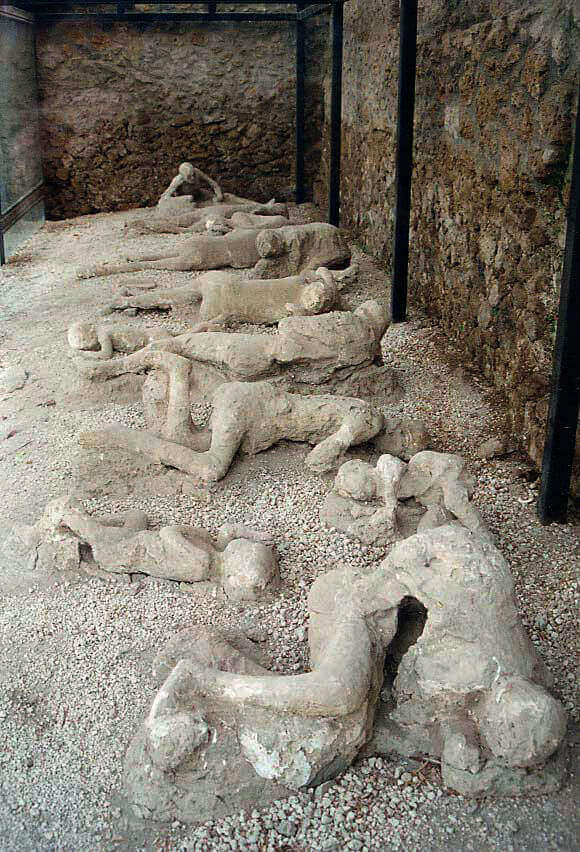
Image source: Wikimedia.

In AD 79, the Roman city of Pompeii was engulfed in scorching heat and ash when the nearby volcano Vesuvius suddenly erupted violently. As a consequence, the city has ceased to exist since then until it was rediscovered again after 1,700 years.
Although the ruined city has yet to be fully excavated, there are more than 1,100 bodies have been found, including animal carcasses. Most bodies were found in small groups nestled together. Also, there are couples in the shape of embracing when dying. Surely, these images are enough for visitors to imagine how desperate and frightened the city’s residents were before the death caused by an extreme natural disaster.
Note: The images of abandoned places used in this post are all found on the internet. Most of them are from Wikimedia, otherwise, they belong to the photographers. I have no authority over any of them. On top of that, I appreciate the owners of the pics a lot and I want to say thank you for letting me use the great images!
What to read next:
- Exploring the Enchanting History of Dunalastair Castle in Scotland
- Rowallan Castle: A Timeless Tale of Majesty, History, and Enchantment
- The Abandoned Glass Mansion of Leesburg, Virginia
- Urban explorer discovers abandoned $12 MILLION mansion.
- Bagni Wildbad: The Elegance of the Past Amidst the Italian Alps
Source: https://numerologybox.com
Category: Abandoned Place



